Hewlett Packard Enterprise WL602 DSL Firewall Router User Manual 3com
Hewlett-Packard Company DSL Firewall Router 3com
Contents
- 1. User Manual Part I
- 2. User Manual Part II
User Manual Part II
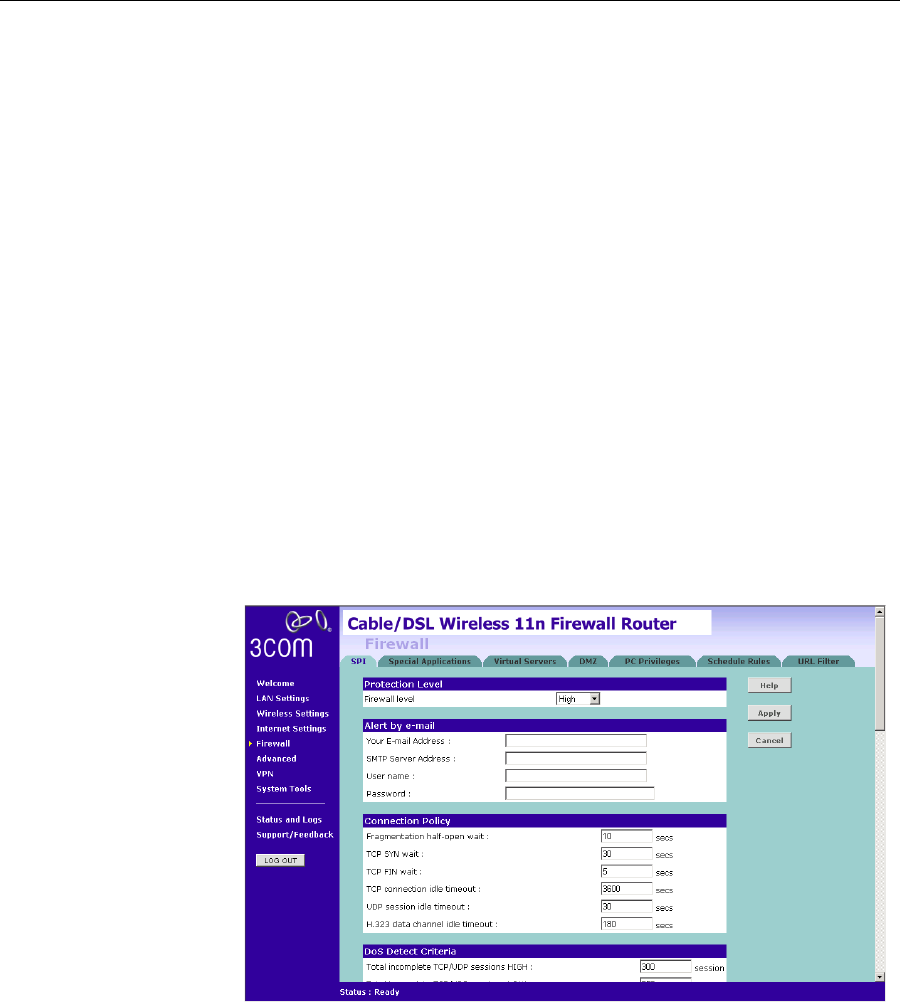
Firewall 69
Firewall This section is for configuration settings of the Router’s firewall function.
Your Router is equipped with a firewall that will protect your network
from a wide array of common hacker attacks including Ping of Death
(PoD) and Denial of Service (DoS) attacks. You can turn the firewall
function off if needed. Turning off the firewall protection will not leave
your network completely vulnerable to hacker attacks, but 3Com
recommends that you leave the firewall enabled whenever possible.
SPI Stateful Packet Inspection (SPI) - The Intrusion Detection Feature of the
Router limits access for incoming traffic at the WAN port.
This feature is called a "stateful" packet inspection, because it examines
the contents of the packet to determine the state of the communications;
i.e., it ensures that the stated destination computer has previously
requested the current communication. This is a way of ensuring that all
communications are initiated by the recipient computer and are taking
place only with sources that are known and trusted from previous
interactions. In addition to being more rigorous in their inspection of
packets, stateful inspection firewalls also close off ports until connection
to the specific port is requested.
Figure 55 Firewall Screen
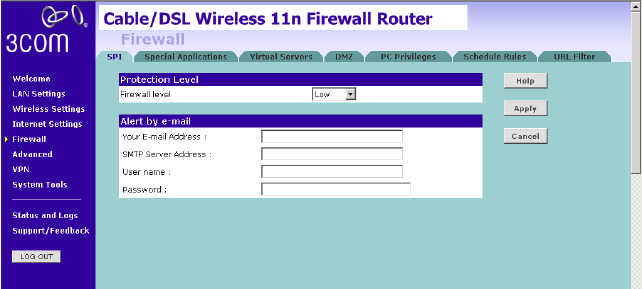
70 CHAPTER 5: CONFIGURING THE ROUTER
To enable the firewall function:
1Select the level of protection (High, Medium, or Low) that you desire from
the Firewall level drop-down menu.
2Click Apply.
■For low and medium levels of firewall protection, refer to Figure 56.
■For high level of firewall protection, refer to Figure 57.
Figure 56 Low and Medium Level Firewall Protection Screen
When abnormal network activity occurs, an alerting email will be sent out
to you. Enter the following information to receive the email:
■Your E-mail Address
■SMTP Server Address
■User name
■Password
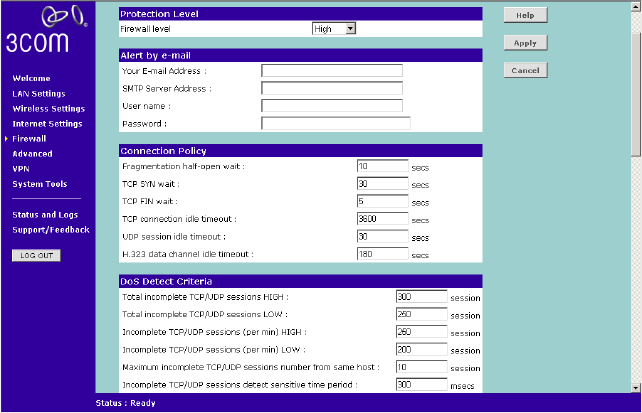
Firewall 71
Figure 57 High Level Firewall Protection Screen
If you select high level of protection, you will need to configure additional
parameters for the firewall.
■Fragmentation half-open wait - Configures the number of seconds
that a packet state structure remains active. When the timeout value
expires, the Router drops the un-assembled packet, freeing that
structure for use by another packet.
■TCP SYN wait - Defines how long the software will wait for a TCP
session to synchronize before dropping the session.
■TCP FIN wait - Specifies how long a TCP session will be maintained
after the firewall detects a FIN packet.
■TCP connection idle timeout - The length of time for which a TCP
session will be managed if there is no activity.
■UDP session idle timeout - The length of time for which a UDP session
will be managed if there is no activity.
■H.323 data channel idle timeout - The length of time for which an
H.323 session will be managed if there is no activity.
72 CHAPTER 5: CONFIGURING THE ROUTER
■Total incomplete TCP/UDP sessions HIGH - Defines the rate of new
unestablished sessions that will cause the software to start deleting
half-open sessions.
■Total incomplete TCP/UDP sessions LOW - Defines the rate of new
unestablished sessions that will cause the software to stop deleting
half-open sessions.
■Incomplete TCP/UDP sessions (per min) HIGH - Maximum number of
allowed incomplete TCP/UDP sessions per minute.
■Incomplete TCP/UDP sessions (per min) LOW - Minimum number of
allowed incomplete TCP/UDP sessions per minute.
■Maximum incomplete TCP/UDP sessions number from same host -
Maximum number of incomplete TCP/UDP sessions from the same
host.
■Incomplete TCP/UDP sessions detect sensitive time period - Length of
time before an incomplete TCP/UDP session is detected as incomplete.
■Maximum half-open fragmentation packet number from same host -
Maximum number of half-open fragmentation packets from the same
host.
■Half-open fragmentation detect sensitive time period - Length of time
before a half-open fragmentation session is detected as half-open.
■Flooding cracker block time - Length of time from detecting a flood
attack to blocking the attack.
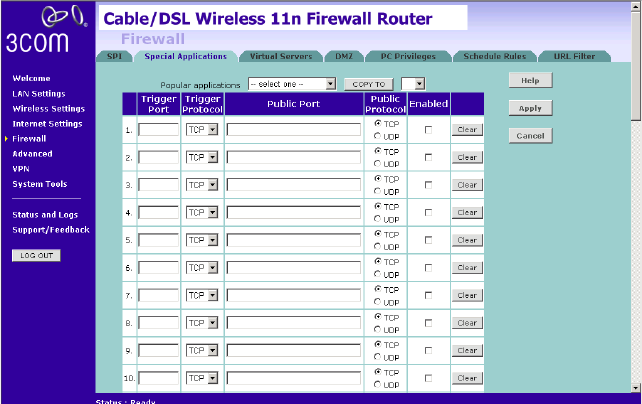
Firewall 73
Special Applications Special Applications let you choose specific ports to be open for specific
applications to work properly with the Network Address Translation (NAT)
feature of the Router.
Figure 58 Special Applications Screen
A list of popular applications has been included to choose from. Select
the application from the Popular Applications drop-down menu. Then
select the row that you want to copy the settings to from the Copy To
drop-down menu, and click Copy To. The settings will be transferred to
the row that you specified. Click Apply to save the setting for that
application.
If your application is not listed, you will need to check with the
application vendor to determine which ports need to be configured. You
can manually enter the port information into the Router. To manually
enter the port information:
1Specify the trigger port (the one used by the application when it is
initialized) in the Trigger Port column, and specify whether the trigger is
TCP or UDP.
2Specify the Public Ports used by the application, that will need to be
opened up in the firewall for the application to work properly. Also
specify whether these ports are TCP or UDP.
3Check the Enabled checkbox, then click Apply.
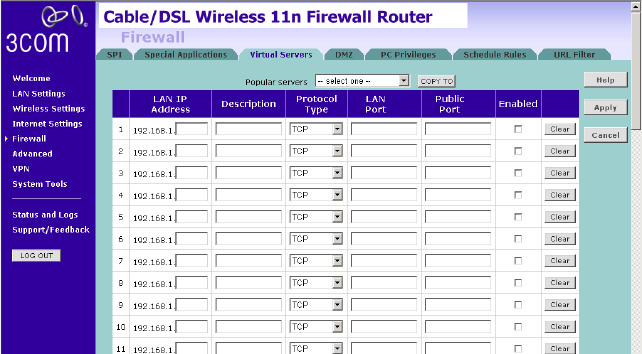
74 CHAPTER 5: CONFIGURING THE ROUTER
Virtual Servers The Virtual servers feature allows you to route external (Internet) calls for
services such as a web server (port 80), FTP server (Port 21), or other
applications through your Router to your internal network. Since your
internal computers are protected by a firewall, machines from the
Internet cannot get to them because they cannot be 'seen'.
If you need to configure the Virtual Server function for a specific
application, you will need to contact the application vendor to find out
which port settings you need.
The maximum number of virtual servers that can be configured is 20.
Figure 59 Virtual Servers Screen
A list of popular servers has been included to choose from. Select the
server from the Popular servers drop-down menu. Then click Add, your
selection will be added to the table.
If the server that you want to use is not listed in the drop-down menu,
you can manually add the virtual server to the table. To manually
configure your virtual servers:
1Enter the IP address, and the description in the spaces provided for the
internal machine.
2Select the protocol type (TCP, UDP, or both TCP and UDP) from the
drop-down menu.
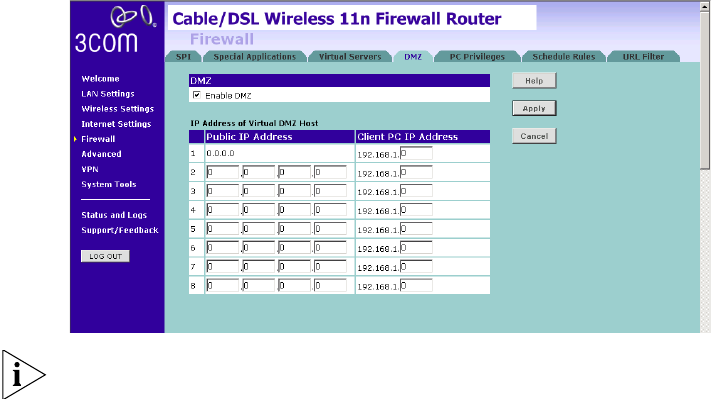
Firewall 75
3Specify the public port that will be seen by clients on the Internet, and the
LAN port which the traffic will be routed to.
4You can enable or disable each Virtual Server entry by checking or
unchecking the appropriate Enabled checkbox.
5Click Apply to save the changes for each Virtual Server entry.
DMZ If you have a client PC that cannot run an Internet application properly
from behind the firewall, you can open the client up to unrestricted
two-way Internet access. This may be necessary if the NAT feature is
causing problems with an application such as a game or video
conferencing application.
Figure 60 DMZ Screen
Use this feature on a temporary basis. The computer in the DMZ is not
protected from hacker attacks.
Check the Enable DMZ box, the IP Address of Virtual DMZ Host will
appear.
1Enter the last digits of the LAN IP address in the Client PC IP Address field.
Enter the IP address (if known) that will be accessing the DMZ PC into the
Public IP Address field, so that only the computer on the Internet at this
address can access the DMZ PC without firewall protection. If the IP
address is not known, or if more than one PC on the Internet will need to
access the DMZ PC, then set the Public IP Address to 0.0.0.0.
2Click Apply.
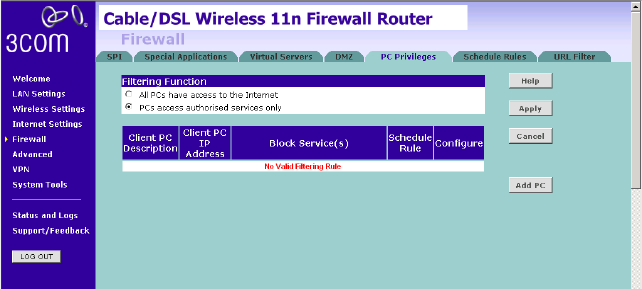
76 CHAPTER 5: CONFIGURING THE ROUTER
PC Privileges The Router can be configured to restrict access to the Internet, email or
other network services at specific days and times. Restriction can be set
for a single computer, a range of computers, or multiple computers.
You can define the traffic type permitted or not-permitted to the Internet.
Figure 61 PC Privileges Screen
1Select one option from filtering function:
■All PCs have access to the Internet: selecting this mode means that all
clients have full access to Internet.
■PCs access authorised services only:
2Click Add PC (refer to Figure 62).
To edit or delete specific existing filtering rules, click on Edit or Delete for
the appropriate filtering rule.
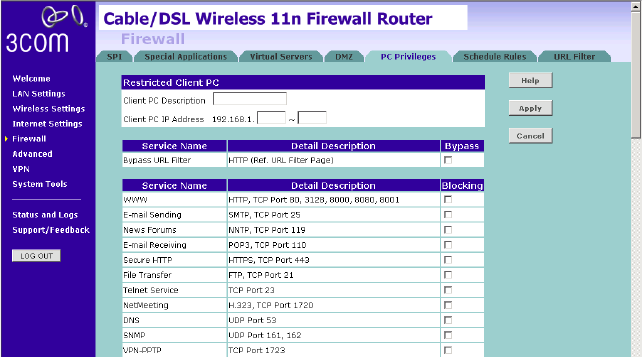
Firewall 77
Figure 62 PC Privileges Add PC Screen
1Enter a description in the Client PC Description field, and the IP address or
IP address range into the Client PC IP Address fields.
2To bypass the URL Filter and Content Filter, check the corresponding
Bypass checkbox.
If you check the two options: Bypass URL Filter, and Bypass Content Filter,
then the Web sites and keywords defined in this screen will not be filtered
out.
3Select the services to be blocked. A list of popular services is listed on this
screen, to block a particular service, check the appropriate Blocking
checkbox.
If the service to be restricted is not listed here, you can enter a custom
range of ports at the bottom of the screen, under User Defined Blocked
Ports.
4If you want the restriction to apply only at certain times, select the
schedule rule to apply from the Schedule Rule drop-down menu.
Note that schedule rules are defined on the Schedule Rules screen
(see page 78).
5Click Apply to add the settings.
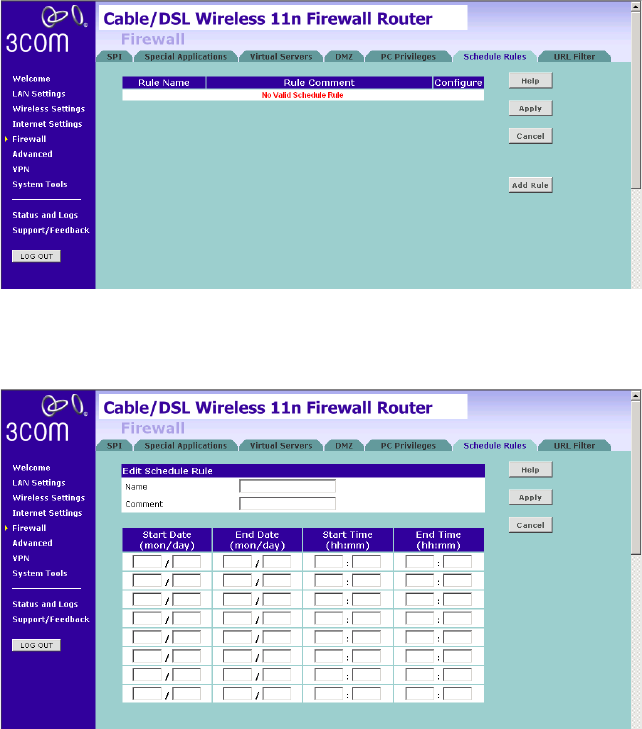
78 CHAPTER 5: CONFIGURING THE ROUTER
Schedule Rule The Router can be configured to restrict access to the Internet, email or
other network services at specific days and times. Define the time in this
screen, and define the rules in the PC Privileges screen (see page 76).
Figure 63 Schedule Rule Screen
1Click Add Rule to add a schedule rule (refer to Figure 64).
Figure 64 Add Schedule Rule Screen
2Enter a name and comment for the schedule rule in the Name and
Comment fields.
3Specify the schedule rules for the required days and times - note that all
times should be in 24 hour format.
4Click Apply.
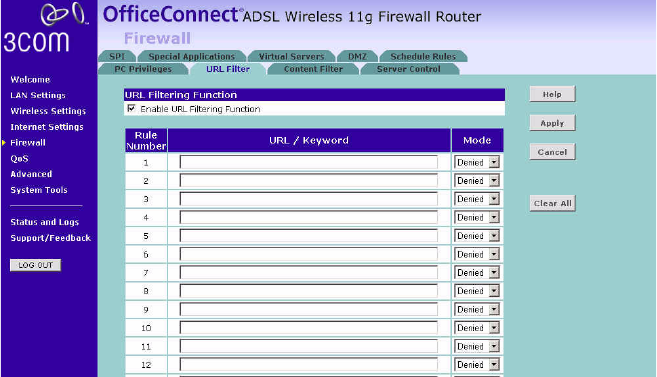
Firewall 79
URL Filter To configure the URL filter feature, use the table on the URL Filter screen
to specify the Web sites (www.somesite.com) and/or keywords you want
to filter on your network.
For example, entering a keyword of xxx would block access to any URL
that contains the string xxx.
Figure 65 URL Filter Screen
1Check the Enable URL Filtering Function checkbox. The rule table will
appear.
2Enter the URL address or keywords in the URL/Keyword field.
3Select Denied or Allowed from the Mode drop-down menu.
To complete this configuration, you will need to create or modify the
filtering rule in the PC Privileges screen (see page 76).
From the PC Privileges Add PC screen (Figure 62), if you check the two
options: Bypass URL Filter, and Bypass Content Filter, then the Web sites
and keywords defined in this screen will not be filtered out.
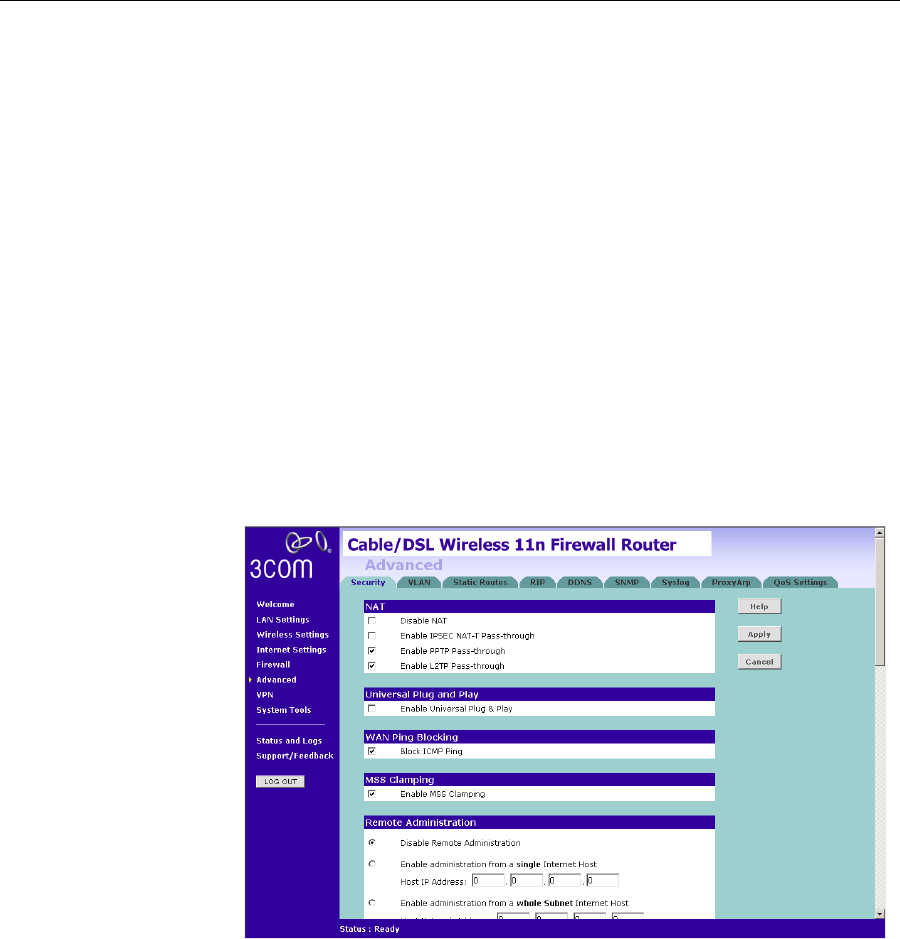
80 CHAPTER 5: CONFIGURING THE ROUTER
Advanced The Advanced section allows you to set additional parameter details for
the Router. You can configure:
■Security
■VLAN
■Static Routes
■RIP
■DDNS
■SNMP
■Syslog
■Proxy Arp
■QoS Settings
Security Use the Security screen to set the advanced security settings for the
Router.
Figure 66 Security Screen
Advanced 81
■NAT — Before you enable NAT (Network Address Translation), make
sure you have changed the administrator password. NAT is the
method by which the Router shares the single IP address assigned by
your ISP with the computers on your network.
This function should only be disabled by advanced users, and if your
ISP assigns you multiple IP addresses or you need NAT disabled for an
advanced system configuration. If you have a single IP address and
you turn NAT off, the computers on your network will not be able to
access the Internet. Other problems may also occur.
■IPSEC NAT-T Pass-through — NAT-T (NAT Traversal) is an Internet
Draft proposed to IETF in order to help the problems associated
with passing IPsec traffic through NAT Routers. For NAT-T to work,
both ends of the connection need to support this function. Ensure
that you select NAT-T only if it is needed as it will reduce LAN-WAN
throughput. This Router supports NAT-T draft 2 implementation.
■Universal Plug and Play — This is a technology that offers seamless
operation of voice messaging, video messaging, games, and other
applications that are Universal Plug and Play compliant. Some
applications require the Router's firewall to be configured in a specific
way to operate properly. This usually requires opening TCP and UDP
ports and in some instances setting trigger ports. An application that
is Universal Plug and Play compliant has the ability to communicate
with the Router, basically "telling" the Router which way it needs the
firewall configured. The Router ships with the Universal Plug and Play
feature disabled. If you are using any applications that are Universal
Plug and Play compliant, and want to take advantage of the Universal
Plug and Play features, you can enable this feature. Simply check the
Enable Universal Plug and Play checkbox. Click Apply to save the
change.
■WAN Ping Blocking — Computer hackers use what is known as
"Pinging" to find potential victims on the Internet. By pinging a
specific IP address and receiving a response from the IP address, a
hacker can determine that something of interest might be there.
The Router can be set up so it will not respond to an Internet Control
Message Protocol (ICMP) Ping from the outside. This heightens the
level of security of your Router. To turn off the ping response, check
Block ICMP Ping and click Apply; the Router will not respond to an
ICMP ping from the Internet.

82 CHAPTER 5: CONFIGURING THE ROUTER
■MSS Clamping — You might not be able to browse some Web sites or
to send email messages that contain attachments from an Internet
Connection Sharing client computer if your outbound connection is
through a Windows XP-based Internet Connection Sharing host
computer that uses Point-to-Point Protocol over Ethernet (PPPoE).
This issue may occur if the Windows XP-based Internet Connection
Sharing host computer uses a smaller Maximum Transmission Unit
(MTU) size on the WAN interface (the PPPoE connection to the
Internet) than it uses on the private interface (the Ethernet connection
to the Internet Connection Sharing client). If a packet is larger than
the MTU size on the WAN interface, the client sends an Internet
Control Message Protocol (ICMP) error to the external server to
request that the server negotiate the TCP Maximum Segment Size
(MSS). However, this message may be blocked by some firewalls.
When this occurs, the packet is dropped. To allow the message to go
through the firewall, enable MSS Clamping. MSS clamping will make
Internet Connection Sharing set the MSS value low enough to match
the external interface.
■Remote Administration — This feature allows you to make changes to
your Router’s settings from anywhere on the Internet. Four options are
available:
■If you do not want to use this feature, select Disable Remote
Administration.
■Select Enable administration from a single Internet Host, and enter
the IP address, to allow only one computer to use the remote
administration. This is more secure, as only the specified IP address
will be able to manage the Router.
■Select Enable administration from a whole Subnet Internet Host,
and enter the IP address and subnet mask, to allow PCs from that
specific subnet group to use the remote administration.
■Select Enable administration from any Internet Host, this allows
any computer to access the Router remotely.
Before you enable this function, ensure that you have set the
Administration Password.
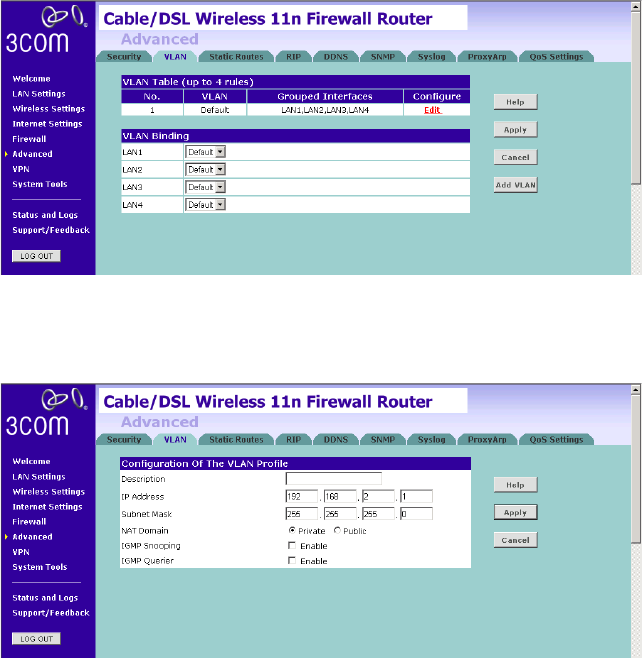
Advanced 83
VLAN The VLAN screen allows you to setup VLAN groups.
Figure 67 VLAN Screen
Click Add VLAN to create a new entry (see Figure 68).
Figure 68 VLAN Profile Screen
■Enter a description for your VLAN in the Description field.
■Enter the IP Address and subnet mask in the corresponding fields.
■Select to set the NAT Domain as public or private.
■IGMP Snooping: enabling it will turn on the feature that allows an
Ethernet switch to “listen in” on the IGMP conversation between
hosts and routers.
■IGMP Querier: enabling this function will send out periodic IGMP
queries.
Click Apply.
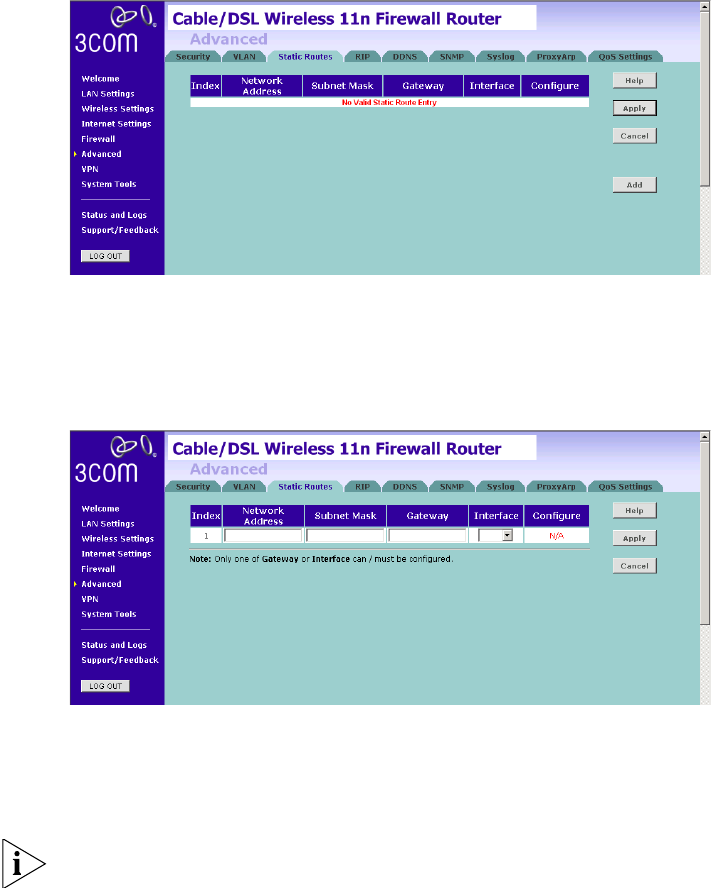
84 CHAPTER 5: CONFIGURING THE ROUTER
Static Routes You can configure static routes in this screen.
Figure 69 Static Routes Screen
To add a static route entry to the table, click Add (see Figure 70).
To change an existing entry, click Edit. To delete an entry, click Delete.
Figure 70 Add Static Route Screen
Enter the following information:
■Network Address — the network address of the static route.
■Subnet Mask — the subnet mask of the route.
A network address of 0.0.0.0 and a subnet mask of 0.0.0.0 indicates the
default route.
■Gateway — the router used to route data to the network specified by
the network address.
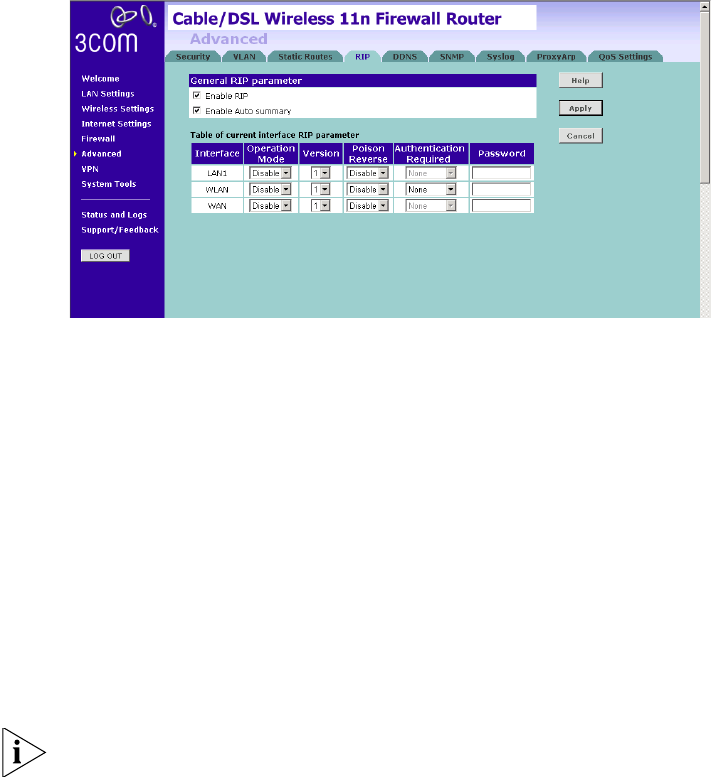
Advanced 85
■Interface — select the interface.
After you have finished making changes to the table, click Apply.
RIP RIP (Routing Information Protocol) - RIP allows the network administrator
to set up routing information on one RIP-enabled device and send that
information to all RIP-enabled devices on the network.
Figure 71 RIP Parameter Screen
You can set up RIP independently on both LAN and WAN interfaces.
1Check the Enable RIP checkbox.
2Check the Enable Auto summary checkbox. Auto summarization sends
simplified routing data to other RIP-enabled devices rather than full
routing data.
3Select the Operation Mode:
■Disable — RIP is not enabled for the WAN or LAN interface.
■Enable — RIP is enabled for the WAN or LAN interface. The router will
transmit RIP update information to other RIP-enabled devices.
■Silent — RIP is enabled, however the Router only receives RIP update
messages, it will not transmit any messages itself.
4In the Version field, select 1 or 2.
3Com recommends that you only use RIPv1 if there is an existing
RIP-enabled device on your network that does not support RIPv2. In all
other cases, you should use RIPv2.
86 CHAPTER 5: CONFIGURING THE ROUTER
5Use the Poison Reverse drop-down menu to enable or disable Poison
Reverse on the Router. Enabling Poison Reverse on your Router allows it
to indicate to other RIP-enabled devices that they have both routes that
point to each other, preventing data loops.
6Use the Authentication Required field to choose the mode of
authentication:
■None — Switches off authentication on the specified interface.
■Password — An unencrypted text password that needs to be set on all
RIP-enabled devices connected to this Router. RIP information is not
shared between devices whose passwords do not match.
7In the Password field, enter the required password.
8Click Apply.
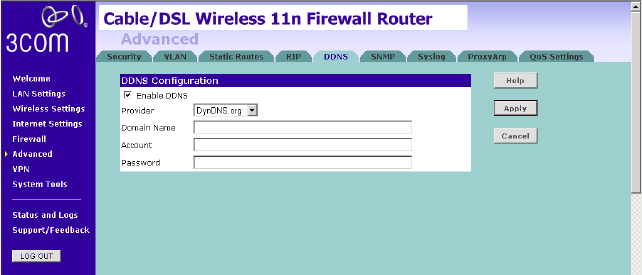
Advanced 87
DDNS The Router provides a list of dynamic DNS providers for you to choose
from. Dynamic Domain Name Server (DDNS) enables you to map a static
domain name to a dynamic IP address.
Before you set up DDNS, you must obtain an account, password or key
and static domain name from your DDNS provider.
The Router supports five DDNS providers:
■DynDNS.org
■TZO.com
■Dt DNS.com
■No-IP.com
■Zoneedit.com
Figure 72 Dynamic Domain Name Server (DDNS) Screen
1Check Enable DDNS.
2Select the provider, and then enter the necessary information provided by
your DDNS provider.
3Click Apply.
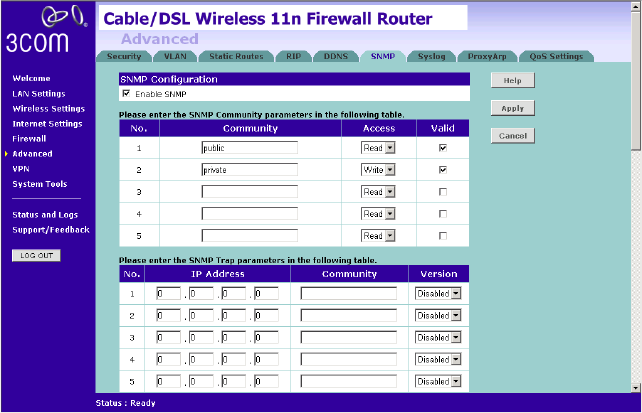
88 CHAPTER 5: CONFIGURING THE ROUTER
SNMP SNMP (Simple Network Management Protocol) allows remote
management of your Router by a PC that has an SNMP management
agent installed.
Check the Enable SNMP box, the table will appear.
Figure 73 SNMP Screen
To Configure SNMP Community:
1In the Community column, enter the name of the SNMP communication
channel. Your SNMP management agent needs to be configured with this
name so that it can communicate with your Router.
2In the Access column, select Read to allow the management agent to
collect data (for example, bandwidth usage) from your Router. Select
Write to allow the management agent to change the configuration of
your Router.
3Check the appropriate Valid checkbox to enable the communication
channel.
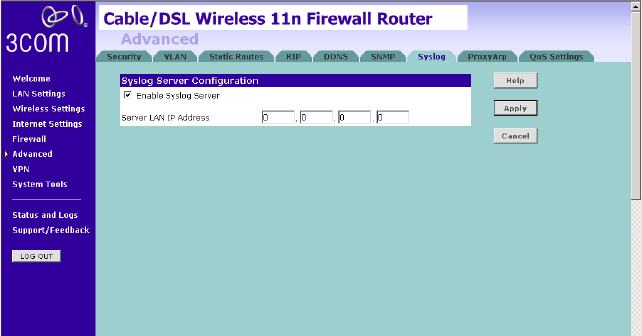
Advanced 89
You can configure your Router to send status messages to the SNMP
management agent if a problem occurs on the network. To configure
SNMP traps:
1In the IP Address field, enter the IP address of the PC to which you want
your Router to send status messages.
2In the Community field, enter the name of the SNMP communication
channel to which you want your Router to send status messages.
3Set the Version field to match the version of trap messaging that your
SNMP management agent supports. The Router supports V1 and V2c
trap messaging.
Syslog Using third party syslog software, this Syslog Server tool will automatically
download the Router log to the specified server IP address.
Figure 74 Syslog Server Screen
1Check the Enable Syslog Server checkbox.
2Enter the Server LAN IP Address in the space provided.
3Click Apply.
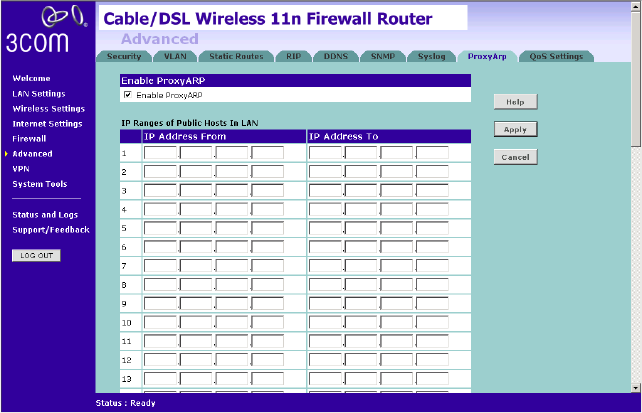
90 CHAPTER 5: CONFIGURING THE ROUTER
Proxy ARP Proxy ARP is the technique in which one host, usually a Router, answers
ARP requests intended for another machine. By “faking” its identity, the
Router accepts responsibility for routing packets to the “real” or intended
destination. This heightens the security for your network.
Figure 75 Proxy ARP Screen
1Check the Enable ProxyARP box.
2Enter the corresponding IP address in the IP Address From and IP Address
To fields.
3Click Apply.
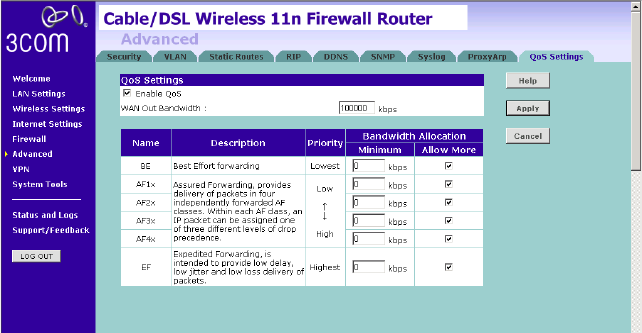
Advanced 91
QoS Settings The QoS (Quality of Service) function allows you to differentiate your
network traffic and provide it with high-priority forwarding service.
The bandwidth gap between LAN and WAN may significantly degrade
performance of critical network applications, such as VoIP, gaming, and
VPN. This QoS function allows you to classify traffic of applications and
provides them with differentiated services (Diffserv).
Figure 76 QoS Settings Screen
1Check the Enable QoS box.
2Enter the value for WAN Out Bandwidth.
3Define the minimum percentage of bandwidth for each type of traffic.
4Check the corresponding box to allow more bandwidth allocation.
5Click Apply.

92 CHAPTER 5: CONFIGURING THE ROUTER
VPN The Router has a Virtual Private Network (VPN) feature that provides a
secure link between remote users and the corporate network by
establishing an authenticated and encrypted tunnel for passing secure
data over the Internet. The Router supports three modes of VPN
operation:
■IPsec (IP Security) — provides IP network-layer encryption. IPSec can
support large encryption networks (such as the Internet) by using
digital certificates for device authentication. When setting up an IPSec
connection between two devices, make sure that they support the
same encryption method.
Note: Enabling IPSec VPN disables pass-through to IPSec and L2TP over
IPSec Virtual Servers on the LAN. Pass-through outbound from clients on
the LAN to servers on the Internet is unaffected.
■PPTP (Point-to-Point Tunneling Protocol) — provides a secure tunnel
for remote client access to a PPTP security gateway. It is not as secure
as IPSec but is easy to administer. PPTP does not support gateway to
gateway connections and is only suitable for connecting remote users.
Check that your ISP’s routers support this protocol before you use it.
Note: Enabling the PPTP Server disables PPTP pass-through to a Virtual
Server on the LAN. Pass-through outbound from clients on the LAN to
servers on the Internet is unaffected.
■L2TP over IPSec — this is a combination of two protocols. L2TP is used
to authenticate a user, and IPSec is used to encrypt data. L2TP over
IPSec does not support gateway to gateway connections and is only
suitable for connecting remote users. Check that your ISP’s routers
support this protocol before you use it.
Note: Enabling L2TP over IPSec disables pass-through to IPSec and L2TP
over IPSec Virtual Servers on the LAN. Pass-through outbound from
clients on the LAN to servers on the Internet is unaffected.
Using the VPN Tunnel Configuration screen, you can add new IPSec, L2TP
over IPSec and PPTP connections, and to edit existing connections. When
adding or editing values on this screen remember that both ends of the
connection must contain the same information.
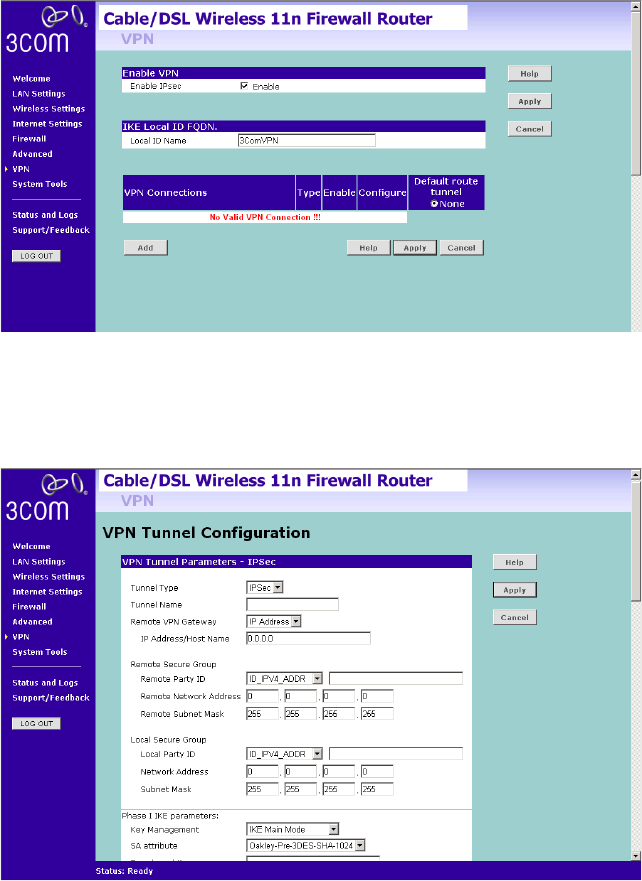
VPN 93
1Check the Enable IPsec box.
Figure 77 VPN Screen
2Enter the Local ID Name of your VPN.
3Click Add to create a new entry.
Figure 78 Add New VPN Tunnel Configuration Screen
94 CHAPTER 5: CONFIGURING THE ROUTER
On the VPN Tunnel Configuration screen,
1Select IPSec as the VPN Tunnel Type.
2Enter a descriptive name for the tunnel in the Tunnel Name field.
3Remote VPN Gateway - select IP address, and then enter the IP address in
the IP Address/Host Name field. If you select ANY, then it would be no
need to enter the IP address, as any remote server can be used.
4At the Remote Party ID drop-down list, select either IP_IPV4_ADDR or
ID_USER_FQDN. This information must be entered identically on the IPSec
software installed on the client’s machine.
Note that if you select IKE Main Mode from the Key Management
drop-down menu (see step 00xx), you must enter IP_IPV4_ADDR here.
5Type a name for the Remote Party ID in the text box area next to the
drop-down menu. This must be unique for each connection rule that you
create.
Enter the following Remote Secure Group information:
■Remote Party ID - select the ID, and then enter the ID in the
corresponding fields.
■If ID_IPV4_ADDR is selected, then enter the ID in the Remote Party
ID field. Enter the IP address and subnet mask in the Remote
Network Address and Remote Subnet Mask fields.
■If ID_USER_FQDN is selected, then enter the ID in the Remote Party
ID field. Enter the IP address and subnet mask in the Remote
Network Address and Remote Subnet Mask fields.
Enter the following Local Secure Group information:
■Local Party ID -
■Network Address
■Subnet Mask
Enter the following Phase I IKE (Internet Key Exchange) parameters:
■Key Management
■SA attribute
■Enter the Pre-shared Key in the field.
VPN 95
Enter the following Phase II IPSec Parameters:
■Authentication Algorithm
■Encrypt Algorithm
■Key lifetime
■PFS
■Diffie-Hellman Group
■IKE Keep Alive -
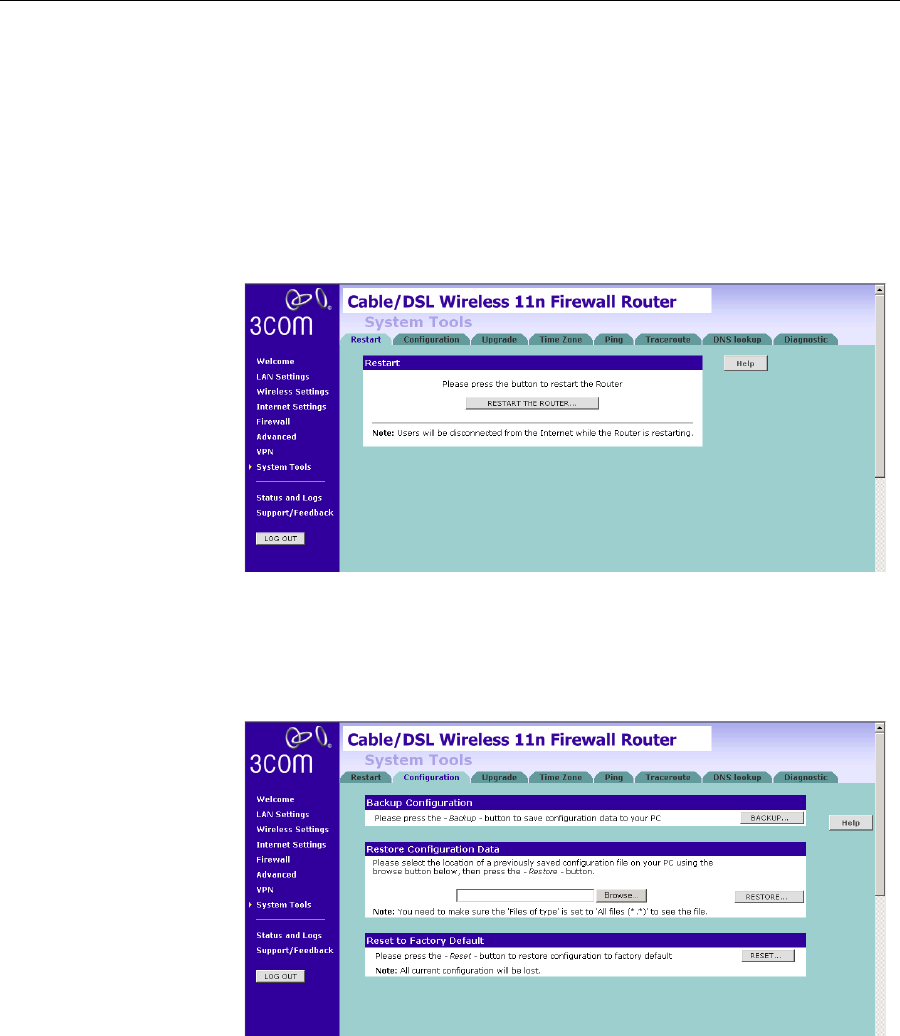
96 CHAPTER 5: CONFIGURING THE ROUTER
System Tools These screens allow you to manage different parameters of the Router
and perform certain administrative functions.
Restart Router Sometimes it may be necessary to restart (or reboot) the Router.
Restarting the Router from this screen will not delete any of your
configuration settings.
Click the Restart the Router button to restart the Router.
Figure 79 Restart Router Screen
Configuration Use this configuration screen to backup, restore or reset the
configuration details of the Router.
Figure 80 Configuration Screen
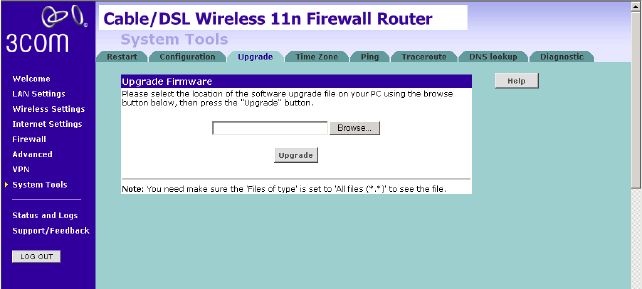
System Tools 97
■Backup Configuration — You can save your current configuration by
clicking the Backup button. Saving your configuration will allow you
to restore it later if your settings are lost or changed. It is
recommended that you backup your current configuration before
performing a firmware update.
■Restore Configuration Data — The Restore Settings option will allow
you to restore a previously saved configuration. Please select the
configuration file using the Browse button and click Restore.
■Reset to Factory Default — Using this option will reset all of the
settings in the Router to the factory default settings. It is
recommended that you backup your settings before you restore all of
the defaults. To restore the factory default settings, click Reset. Note
that all of your current configuration will be lost.
Upgrade From time to time 3Com may release new versions of the Router’s
firmware. Firmware updates contain improvements and fixes to problems
that may have existed.
Figure 81 Upgrade Screen
Please download the firmware file to your PC first, and then click Browse
to locate the file, and select the firmware file. Click Upgrade to upload
the firmware to the Router.
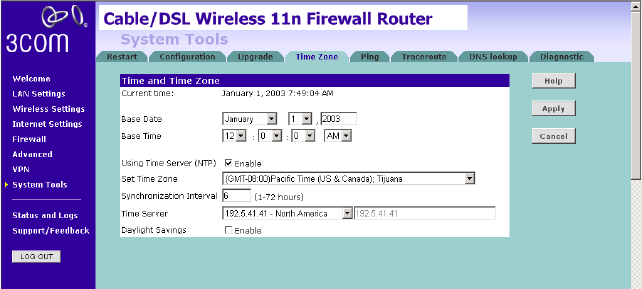
98 CHAPTER 5: CONFIGURING THE ROUTER
Time Zone You can set the time settings for the Router on this screen.
Figure 82 Time Zone Screen
The Router keeps time by connecting to a Network Time Protocol (NTP)
server. This allows the Router to synchronize the system clock to the
Internet. The synchronized clock in the Router is used to record the
security log and control client filtering. Select the time zone that you
reside in.
If you reside in an area that observes Daylight Saving, then check the
Enable Daylight Savings box. The system clock may not update
immediately. Allow at least 15 minutes for the Router to contact the time
servers on the Internet and get a response. You cannot set the clock
yourself.
You can specify which NTP servers the Router will use to update the
system clock, although doing this should only be necessary if you are
experiencing difficulty.
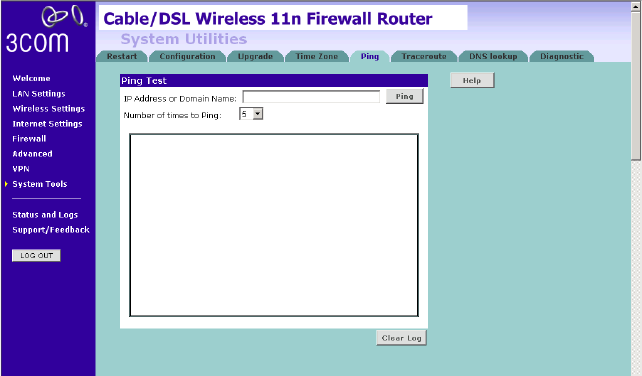
System Tools 99
Ping The ping tool is used to test if the network is working properly.
Figure 83 Ping Screen
1Enter the IP address or domain name in the IP Address or Domain Name
field, and click Ping.
2Select from the Number of times to Ping drop-down menu.
3The Router keeps a log of the ping test, click Clear Log to delete the
records.
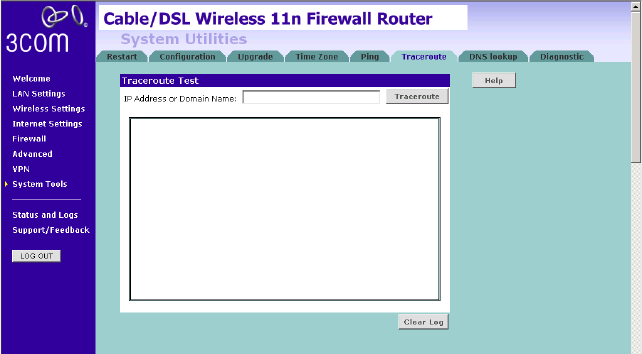
100 CHAPTER 5: CONFIGURING THE ROUTER
Traceroute Traceroute is the program that shows you the route over the network
between two systems, listing all the intermediate routers a connection
must pass through to get to its destination. It can help you determine
why your connections to a given server might be poor, and can often help
you figure out where exactly the problem is. It also shows you how
systems are connected to each other, letting you see how your ISP
connects to the Internet as well as how the target system is connected.
Figure 84 Traceroute Screen
1Enter the IP address or domain name in the IP Address or Domain Name
field, and click Traceroute.
2The Router keeps a log of the traceroute test, click Clear Log to delete the
records.
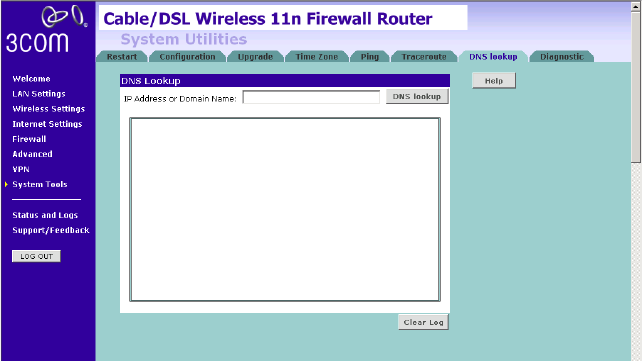
System Tools 101
DNS Lookup DNS Lookup is the process of resolving an IP address
(i.e. 192.168.11.137) to a host name (i.e. xxxcompany.net).
Figure 85 DNS Lookup Screen
1Enter the IP address or domain name in the IP Address or Domain Name
field, and click Dns lookup.
2The Router keeps a log of the DNS lookup test, click Clear Log to delete
the records.
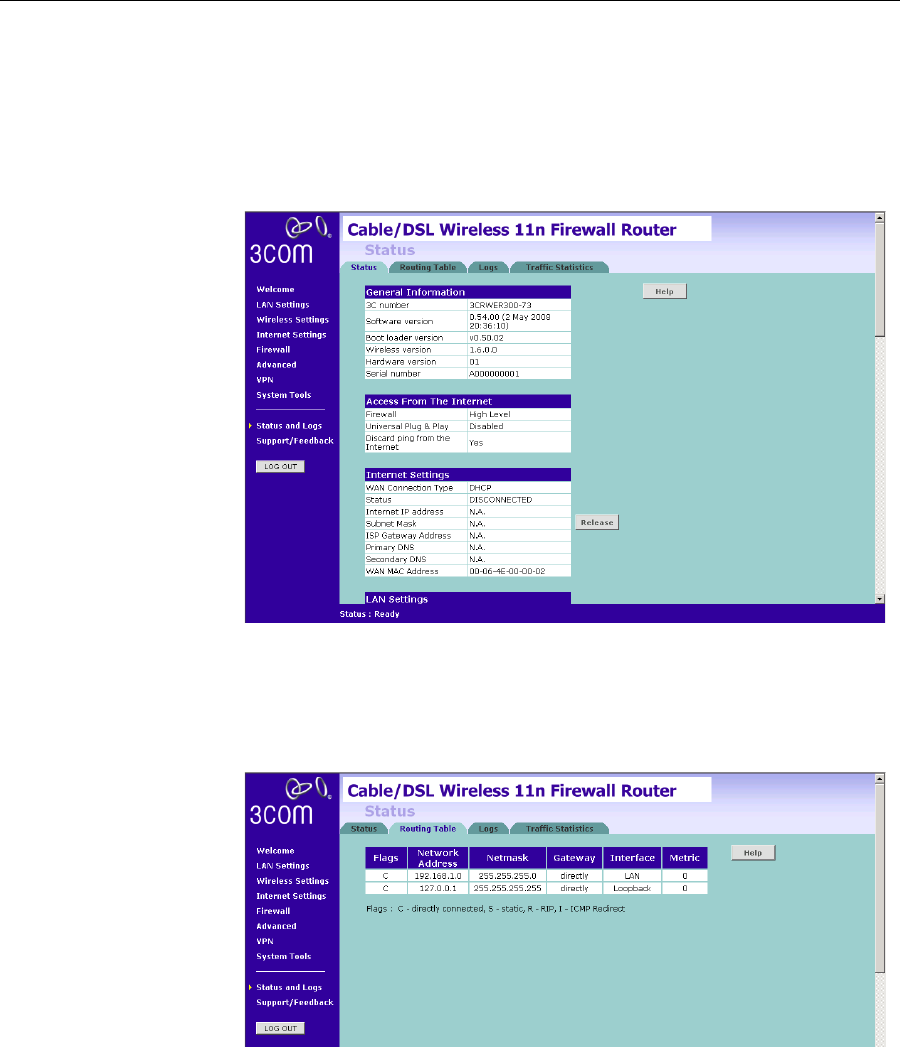
102 CHAPTER 5: CONFIGURING THE ROUTER
Status and Logs You can use the Status Screen to view version numbers for your Router’s
software and hardware and check the status of connections to WAN,
LAN and WLAN interfaces.
Status This screen shows Router status and statistics.
Figure 86 Status Screen
Routing Table This screen displays details for the default routing used by your Router
and any routing created using Static Routing or RIP.
Figure 87 Routing Table Screen
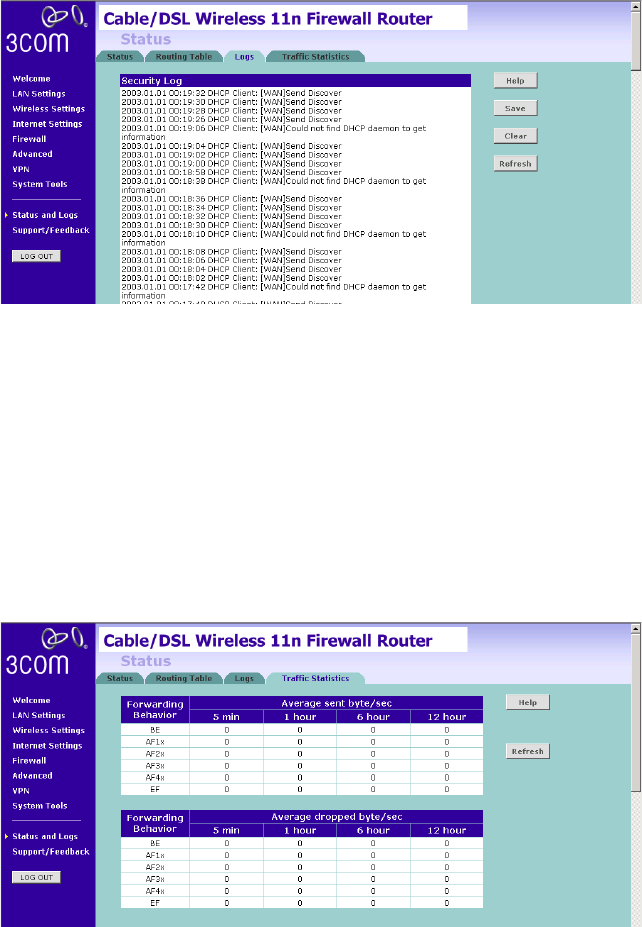
Status and Logs 103
Logs This screen shows any attempts that have been made to gain access to
your network as well as the system activities.
Figure 88 Logs Screen
■Click Help to view the help file.
■Click Save to save the log to the hard disk as a text file. When
prompted for a location to save the file to, specify a filename and
location, and then click OK.
■Click Clear to clear the log (note that all current entries will be erased).
■Click Refresh to update the record.
Traffic Statistics This screen shows the traffic statistics.
Figure 89 Traffic Statistics Screen
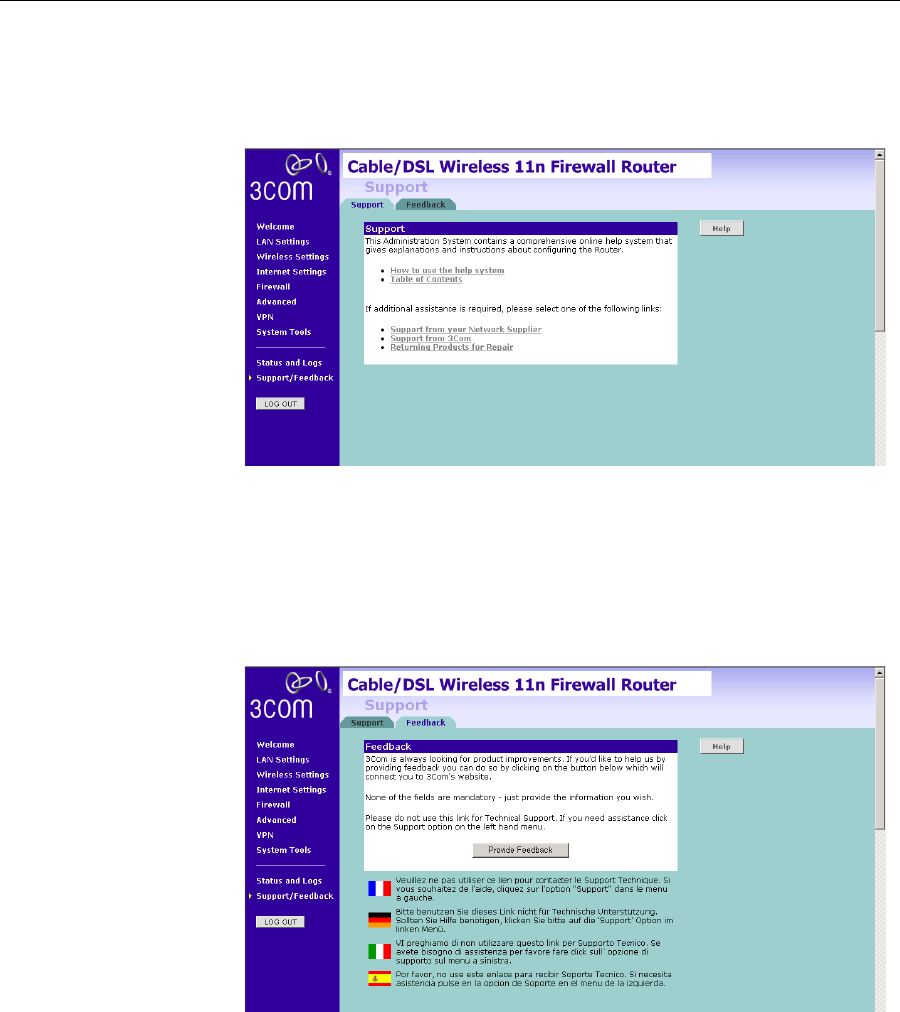
104 CHAPTER 5: CONFIGURING THE ROUTER
Support/Feedback You can use the Support/Feedback screen to obtain support and help,
and also provide feedback to 3Com.
Support Figure 90 Support Screen
This screen shows support information.
Feedback To provide feedback to 3Com, please click Provide Feedback, and this will
connect you to the 3Com Web site.
Figure 91 Feedback Screen
This screen shows feedback information.

6TROUBLESHOOTING
Basic Connection
Checks
■Check that the Router is connected to your computers and to the
telephone line, and that all the equipment is powered on. Check that
the LAN Status and SYNC LEDs on the Router are illuminated, and that
any corresponding LEDs on the NIC are also illuminated.
■Ensure that the computers have completed their start-up procedure
and are ready for use. Some network interfaces may not be correctly
initialized until the start-up procedure has completed.
■If the link status LED does not illuminate for a port that is connected,
check that you do not have a faulty cable. Try a different cable.
Browsing to the
Router
Configuration
Screens
If you have connected your Router and computers together but cannot
browse to the Router configuration screens, check the following:
■Confirm that the physical connection between your computer and the
Router is OK, and that the LAN Status LEDs on the Router and
network adapter are illuminated and indicating the same speed
(10Mbps or 100Mbps). Some NICs do not have status LEDs, in which
case a diagnostic program may be available that can give you this
information.
■Ensure that you have configured your computer as described in
Chapter 3. Restart your computer while it is connected to the Router
to ensure that your computer receives an IP address.
■When entering the address of the Router into your web browser,
ensure that you use the full URL including the http:// prefix (e.g.
http://192.168.1.1).
■Ensure that you do not have a Web proxy enabled on your computer.
Go to the Control Panel and click on Internet Options. Select the
Connections tab and click on the LAN Settings button at the bottom.
Make sure that the Proxy Server option is unchecked.

106 CHAPTER 6: TROUBLESHOOTING
■If you cannot browse to the Router, use the winipcfg utility in
Windows 98/ME to verify that your computer has received the correct
address information from the Router. From the Start menu, choose
Run and then enter winipcfg. Check that the computer has an IP
address of the form 192.168.1.xxx (where xxx is in the range 2-254),
the subnet mask is 255.255.255.0, and the default Router is
192.168.1.1 (the address of the Router). If these are not correct, use
the Release and Renew functions to obtain a new IP address from the
Router. Under Windows 2000 and Windows XP, use the ipconfig
command-line utility to perform the same functions.
Connecting to the
Internet
If you can browse to the Router configuration screens but cannot access
Web sites on the Internet, check the following:
■Confirm that the physical connection between the Router and the
telephone line is OK, and that the DSL LED on the Router is
illuminated.
■Ensure that you have entered the correct information into the Router
configuration screens as required by your Internet Service Provider. Use
the Internet Settings screen to verify this.
■Check that the PPPoE or PPPoA user name and password are correct.
■Ensure that your computers are not configured to use a Web proxy.
On Windows computers, this can be found under Control Panel >
Internet Options > Connections.
Forgotten Password
and Reset to
Factory Defaults
If you can browse to the Router configuration screen but cannot log on
because you do not know or have forgotten the password, follow the
steps below to reset the Router to its factory default configuration.
CAUTION: All your configuration changes will be lost, and you will need
to run the configuration wizard again before you can re-establish your
Router connection to the Internet. Also, other computer users will lose
their network connections whilst this process is taking place, so choose a
time when this would be convenient.
1Power off the Router.
2Disconnect all your computers and the telephone line from the Router.
3Re-apply power to the Router, and wait for it to finish booting up.

Wireless Networking 107
4Press and hold the Reset button on the rear panel (see Figure 4 on
page 16) for 5 seconds.
5The Router will restart, and when the start-up sequence has completed,
browse to:
http://192.168.1.1
and run the configuration wizard. You may need to restart your computer
before you attempt this.
6When the configuration wizard has completed, you may reconnect your
network as it was before.
Wireless
Networking
■Ensure that you have an 802.11b or 802.11g or 802.11n wireless
adapter for each wireless computer, and that it is correctly installed
and configured. Verify that each wireless computer has either
Windows 98 or higher or MAC OS 8.5 or higher.
■Verify that your wireless computers are configured to work in
Infrastructure mode and not Ad Hoc mode. The Router contains an
Access Point that is designed to operate in Infrastructure mode. Ad
Hoc mode is not supported by the Router.
■If you have a wired and a wireless NIC in the same computer, ensure
that the wired NIC is disabled.
■Check the status of the WLAN LED, it should be lit if wireless is
enabled and will flash when there is wireless activity. If not lit go to
Wireless Settings on page 47 and enable wireless networking.
■Ensure that the TCP/IP settings for all devices are correct.
■Ensure that the Wireless Clients are using the same SSID or Service
Area Name as the Router. The SSID is case-sensitive.
■Ensure that the encryption method and level that you use on your
clients are the same as those configured on the Router. The Router
cannot simultaneously support WPA and WEP encryption.
■Ensure that you have the wireless computer enabled in the list of
allowed MAC addresses if you are using MAC Address Filtering on the
Router.
■If you are having difficulty connecting or are operating at a low speed
try changing the antenna positions on the rear of the Router.
For more effective coverage you can try reorientating your antennae.
Place one antenna vertically and one horizontally to improve coverage.
108 CHAPTER 6: TROUBLESHOOTING
Additionally consider moving the wireless computer closer to the
Router to confirm that the building structure or fittings are not
adversely affecting the connectivity. If this resolves the problem
consider relocating the wireless computer or the Router, or trying a
different channel on the Router.
■Sources of interference: The 2.4Ghz ISM band is used for 802.11b and
802.11g. This is generally a licence free band for low power
applications, and you may have other devices at your location that
operate in this frequency band. You should take care to ensure that
there are no devices, like microwave ovens for example, close to the
Router or wireless computers as this could affect receiver sensitivity
and reduce the performance of your network. If you are unsure try
relocating both the wireless computers and the Router to establish
whether this problem exists.
■Most wireless computer adapters will scan the channels for the
wireless Router. If a wireless computer has not located the Router then
try initiating a search manually if the client software supports this
feature or manually set the channel on your wireless computer to
correspond to the Router channel number. Please refer to your
wireless computer adapter documentation and vendor to do this.
■Speed of connection: The 802.11b and 802.11g standards will
automatically choose the best speed depending on the quality of your
connection. As the signal quality weakens then the speed falls back to
a lower speed. The speeds supported by 802.11g are 54 Mbps,
48 Mbps, 36 Mbps, 24 Mbps, 18 Mbps, 12 Mbps and 6 Mbps. The
speeds supported by 802.11b are 11 Mbps, 5.5 Mbps, 2 Mbps and
1 Mbps. In general the closer you are to the Router the better the
speed. If you are not achieving the speed you had anticipated then try
moving the antenna on the Router or moving the wireless computer
closer to the Router. In an ideal network the Router should be located
in the centre of the network with wireless computers distributed
around it. Applications are generally available with the computer
wireless card to carry out a site survey. Use this application to find the
optimal siting for your wireless computer. Consult your Computer
Card documentation and vendor for more details.

Recovering from Corrupted Software 109
Recovering from
Corrupted Software
If the system software has become corrupted, the Router will enter a
“recovery” state; DHCP is enabled, and the LAN IP address is set to
192.168.1.1. Follow the instructions below to upload a new copy of the
system software to a Router unit in this state.
Ensure that one of your computers has a copy of the new software image
file stored on its hard disk or available on CD-ROM.
Check your ISP for the latest version firmware.
1Remove power from the Router and disconnect the telephone line and all
your computers, except for the one computer with the software image.
2You will need to reconfigure this computer to obtain an IP address
automatically (see Obtaining an IP Address Automatically on page 23).
3Restart the computer, and re-apply power to the Router.
4Using the Web browser on the computer, enter the following URL in the
location bar:
http://192.168.1.1.
This will connect you to the Recovery utility in the Router.
5Follow the on-screen instructions. Enter the path and filename of the
software image file.
6When the upload has completed, the Router will restart, run the self-test
and, if successful, resume normal operation.
7Refer to the Installation Guide to reconnect your Router to the telephone
line and the computers in your network. Do not forget to reconfigure the
computer you used for the software upload.
If the Router does not resume normal operation following the upload, it
may be faulty. Contact your supplier for advice.

110 CHAPTER 6: TROUBLESHOOTING
Frequently Asked
Questions How do I reset the Router to Factory Defaults?
See Forgotten Password and Reset to Factory Defaults on
page 106.
How many computers on the LAN does the Router support?
A maximum of 253 computers on the LAN are supported.
How many wireless clients does the Router support?
A maximum of 128 wireless clients are supported.
There are only 4 LAN ports on the Router. How are additional
computers connected?
You can expand the number of connections available on your LAN
by using hubs, switches and wireless access points connected to
the Router. 3Com wireless access points and hubs and switches
provide a simple, reliable means of expanding your network;
contact your supplier for more information, or visit:
http://www.3com.com/
Does the Router support virtual private networks (VPNs)?
The Router supports VPN passthrough, which allows VPN clients on
the LAN to communicate with VPN hosts on the Internet. It is also
possible to set up VPN hosts on your LAN that clients elsewhere on
the Internet can connect to, but this is not a recommended
configuration.

AIP ADDRESSING
The Internet
Protocol Suite
The Internet Protocol suite consists of a well-defined set of
communications protocols and several standard application protocols.
Transmission Control Protocol/Internet Protocol (TCP/IP) is probably the
most widely known and is a combination of two of the protocols (IP and
TCP) working together. TCP/IP is an internationally adopted and
supported networking standard that provides connectivity between
equipment from many vendors over a wide variety of networking
technologies.
Managing the
Router over the
Network
To manage a device over the network, the Router must be correctly
configured with the following IP information:
■An IP address
■A Subnet Mask
IP Addresses and
Subnet Masks
Each device on your network must have a unique IP address to operate
correctly. An IP address identifies the address of the device to which data
is being sent and the address of the destination network. IP addresses
have the format n.n.n.x where n is a decimal number between 0 and 255
and x is a number between 1 and 254 inclusive.
However, an IP address alone is not enough to make your device operate.
In addition to the IP address, you need to set a subnet mask. All networks
are divided into smaller sub-networks and a subnet mask is a number
that enables a device to identify the sub-network to which it is
connected.

112 APPENDIX A: IP ADDRESSING
For your network to work correctly, all devices on the network must have:
■The same sub-network address.
■The same subnet mask.
The only value that will be different is the specific host device number.
This value must always be unique.
An example IP address is ‘192.168.100.8’. However, the size of the
network determines the structure of this IP address. In using the Router,
you will probably only encounter two types of IP address and subnet
mask structures.
Type One
In a small network, the IP address of ‘192.168.100.8’ is split into two
parts:
■Part one (‘192.168.100’) identifies the network on which the device
resides.
■Part two (‘.8’) identifies the device within the network.
This type of IP address operates on a subnet mask of ‘255.255.255.0’.
See Ta bl e 3 for an example about how a network with three computers
and a Router might be configured.
Table 3 IP Addressing and Subnet Masking
Type Two
In larger networks, where there are more devices, the IP address of
‘192.168.100.8’ is, again, split into two parts but is structured differently:
■Part one (‘192.168’) identifies the network on which the device
resides.
■Part two (‘.100.8’) identifies the device within the network.
Device IP Address Subnet Mask
PC 1 192.168.100.8 255.255.255.0
PC 2 192.168.100.33 255.255.255.0
PC 3 192.168.100.188 255.255.255.0
Router 192.168.100.72 255.255.255.0

How does a Device Obtain an IP Address and Subnet Mask? 113
This type of IP Address operates on a subnet mask of ‘255.255.0.0’.
See Ta bl e 4 for an example about how a network (only four computers
represented) and a Router might be configured.
Table 4 IP Addressing and Subnet Masking
How does a Device
Obtain an IP
Address and Subnet
Mask?
There are three different ways to obtain an IP address and the subnet
mask. These are:
■Dynamic Host Configuration Protocol (DHCP) Addressing
■Static Addressing
■Automatic Addressing (Auto-IP Addressing)
DHCP Addressing The Router contains a DHCP server, which allows computers on your
network to obtain an IP address and subnet mask automatically. DHCP
assigns a temporary IP address and subnet mask which gets reallocated
once you disconnect from the network.
DHCP will work on any client Operating System such as Windows 98,
Windows NT 4.0, Windows 2000, Windows XP, and Windows Vista.
Also, using DHCP means that the same IP address and subnet mask will
never be duplicated for devices on the network. DHCP is particularly
useful for networks with large numbers of users on them.
Static Addressing You must enter an IP Address and the subnet mask manually on every
device. Using a static IP and subnet mask means the address is
permanently fixed.
Auto-IP Addressing Network devices use automatic IP addressing if they are configured to
acquire an address using DHCP but are unable to contact a DHCP server.
Automatic IP addressing is a scheme where devices allocate themselves
Device IP Address Subnet Mask
PC 1 192.168.100.8 255.255.0.0
PC 2 192.168.201.30 255.255.0.0
PC 3 192.168.113.155 255.255.0.0
PC 4 192.168.002.230 255.255.0.0
Router 192.168.002.72 255.255.0.0
114 APPENDIX A: IP ADDRESSING
an IP address at random from the industry standard subnet of
169.254.x.x (with a subnet mask of 255.255.0.0). If two devices allocate
themselves the same address, the conflict is detected and one of the
devices allocates itself a new address.
Automatic IP addressing support was introduced by Microsoft in the
Windows 98 operating system and is also supported in Windows 2000
and Windows XP.

BTECHNICAL SPECIFICATIONS
This section lists the technical specifications for the 3Com Wireless 11n
Cable/DSL Firewall Router.
3Com Wireless 11n
Cable/DSL Firewall
Router
Interfaces
WAN connection
LAN connection — four 10 Mbps/100 Mbps dual speed Ethernet ports
(10BASE-T/100BASE-TX)
WLAN Interfaces
IEEE draft 802.11n, Orthogonal Frequency Division Multiplexing (OFDM)
Transmission rate: 802.11n 40MHz: 270Mbps, automatic fallback to 243,
216, 162, 135, 121,5, 108, 81, 54, 40.5, 27, 13.5Mbps
802.11n 20MHz: 130Mbps, automatic fallback to 117, 104, 78, 65, 58.5,
52, 39, 26, 19.5, 13, 6.5Mbps
Maximum channels: 13
Range up to 304.8m (1000ft)
Sensitivity: 11 Mbps: -82 dBm; 54 Mbps: -68 dBm;
MCS15 (20MHz): -65 dBm ; MCS15 (40MHz): -62 dBm
Modulation: CCK, BPSK, QPSK, OFDM
Encryption: 40/64 bit WEP, 128 bit WEP, WPA/WPA2
Maximum clients: 128
O/P Power: 14dBm
Standard IEEE 802.11g, Direct Sequence Spread Spectrum (DSSS)
Transmission rate: 54 Mbps, automatic fallback to 48, 36, 24, 18, 12, or
6Mbps
Maximum channels: 13
Range up to 304.8m (1000ft)
Sensitivity: 6, 12, 18, 24, 36, 48 Mbps: -85 dBm;
54 Mbps -66 dBm typical
116 APPENDIX B: TECHNICAL SPECIFICATIONS
Modulation: CCK, BPSK, QPSK, OFDM
Encryption: 40/64 bit WEP, 128 bit WEP, WPA/WPA2
Maximum clients: 128
O/P Power: 14dBm
Standard IEEE 802.11b, Direct Sequence Spread Spectrum (DSSS)
Transmission rate: 11Mbps, automatic fallback to 5.5, 2, or 1 Mbps
Maximum channels: 13
Range up to 304.8m (1000ft)
Sensitivity: 1, 2, 5.5 Mbps: -85 dBm; 11 Mbps -82 dBm typical
Modulation: CCK, BPSK, QPSK
Encryption: 40/64 bit WEP, 128 bit WEP, WPA/WPA2
Maximum clients: 128
O/P Power 18dBm
Operating Temperature
0 °C to 40 °C (32 °F to 105 °F)
Power
12V1A/15V1A
Humidity
0% to 90% (non-condensing) humidity
Dimensions
■Width = 178 mm (7.0 in.)
■Depth = 160 mm (6.1 in.)
■Height = 39 mm (1.5 in.)
Weight
Approximately 285 g
Standards Functional: ISO 8802/3
IEEE 802.3
IEEE 802.11b, 802.11g
Safety: EN 60950-1: 2001
UL 60950-1
IEC 60950-1: 2001
3Com Wireless 11n Cable/DSL Firewall Router 117
EMC: FCC Part15 B
EN 55022
EN 55024
EN 61000
EN 301 489-1
ICES-003
Radio FCC Part 15 C
RSS-210
EN 300 328
Environmental: EN 60068 (IEC 68)
*See “Regulatory Notices” for conditions of operation.
118 APPENDIX B: TECHNICAL SPECIFICATIONS
System Requirements Operating Systems
The Router will support the following Operating Systems:
■Windows 98Se
■Windows NT 4.0
■Windows ME
■Windows 2000
■Windows XP
■Windows Vista
■Mac OS 8.5 or higher
■Unix
Ethernet Performance The Router complies to the IEEE 802.3i, u and x specifications.
Cable Specifications The Router supports the following cable types and maximum lengths:
■Category 3 (Ethernet) or Category 5 (Fast Ethernet or Dual Speed
Ethernet) Twisted Pair — shielded and unshielded cable types.
■Maximum cable length of 100m (327.86 ft).
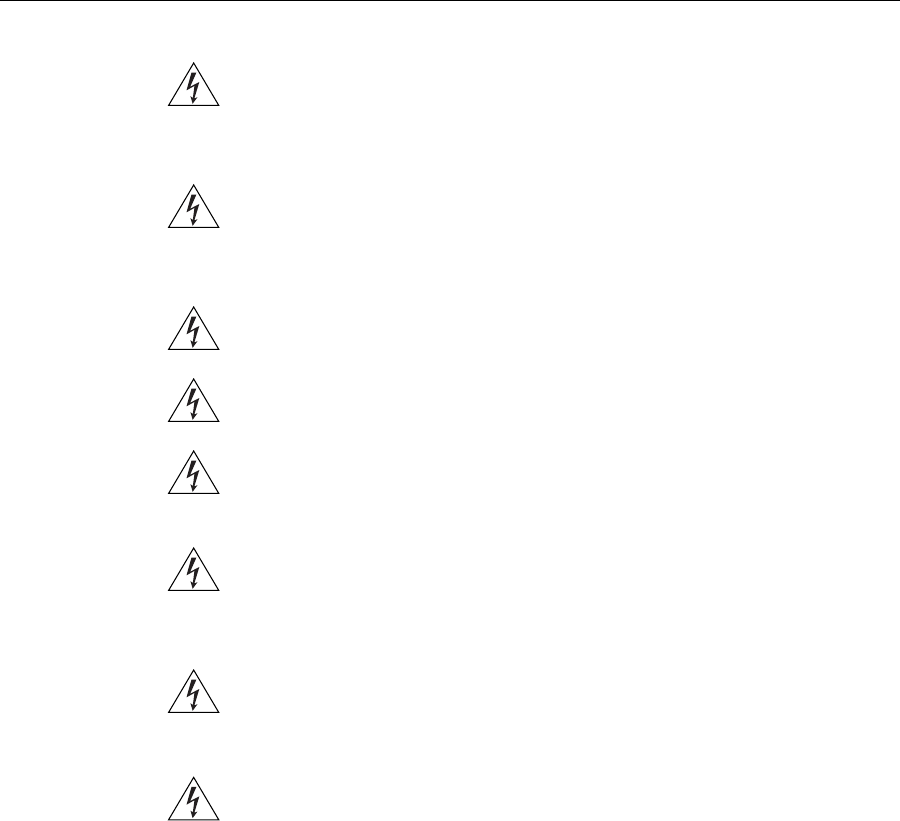
CSAFETY INFORMATION
Important Safety
Information
WARNING: Warnings contain directions that you must follow for your
personal safety. Follow all directions carefully.
You must read the following safety information carefully before you
install or remove the unit:
WARNING: The Router generates and uses radio frequency (rf) energy. In
some environments, the use of rf energy is not permitted. The user
should seek local advice on whether or not rf energy is permitted within
the area of intended use.
WARNING: Exceptional care must be taken during installation and
removal of the unit.
WARNING: To ensure compliance with international safety standards,
only use the power adapter that is supplied with the unit.
WARNING: The socket outlet must be near to the unit and easily
accessible. You can only remove power from the unit by disconnecting
the power cord from the outlet.
WARNING: This unit operates under SELV (Safety Extra Low Voltage)
conditions according to IEC 60950. The conditions are only maintained
if the equipment to which it is connected also operates under SELV
conditions.
WARNING: There are no user-replaceable fuses or user-serviceable
parts inside the Router. If you have a physical problem with the unit
that cannot be solved with problem solving actions in this guide,
contact your supplier.
WARNING: Disconnect the power adapter before moving the unit.
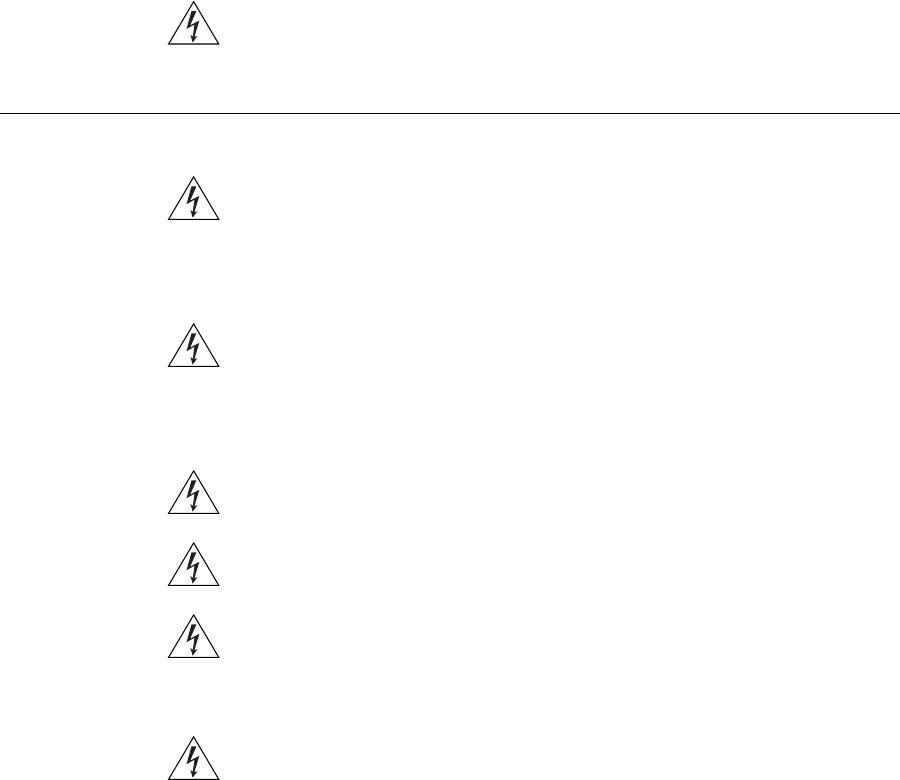
120 APPENDIX C: SAFETY INFORMATION
WARNING: RJ-45 ports. These are shielded RJ-45 data sockets. They
cannot be used as telephone sockets. Only connect RJ-45 data
connectors to these sockets.
Wichtige
Sicherheitshinweise
VORSICHT: Warnhinweise enthalten Anweisungen, die Sie zu Ihrer
eigenen Sicherheit befolgen müssen. Alle Anweisungen sind sorgfältig
zu befolgen.
Sie müssen die folgenden Sicherheitsinformationen sorgfältig
durchlesen, bevor Sie das Geräts installieren oder ausbauen:
VORSICHT: Der Router erzeugt und verwendet Funkfrequenz (RF). In
manchen Umgebungen ist die Verwendung von Funkfrequenz nicht
gestattet. Erkundigen Sie sich bei den zuständigen Stellen, ob die
Verwendung von Funkfrequenz in dem Bereich, in dem der Bluetooth
Access Point eingesetzt werden soll, erlaubt ist.
VORSICHT: Bei der Installation und beim Ausbau des Geräts ist mit
höchster Vorsicht vorzugehen.
VORSICHT: Aufgrund von internationalen Sicherheitsnormen darf das
Gerät nur mit dem mitgelieferten Netzadapter verwendet werden.
VORSICHT: Die Netzsteckdose muß in der Nähe des Geräts und leicht
zugänglich sein. Die Stromversorgung des Geräts kann nur durch
Herausziehen des Gerätenetzkabels aus der Netzsteckdose
unterbrochen werden.
VORSICHT: Der Betrieb dieses Geräts erfolgt unter den
SELV-Bedingungen (Sicherheitskleinstspannung) gemäß IEC 60950.
Diese Bedingungen sind nur gegeben, wenn auch die an das Gerät
angeschlossenen Geräte unter SELV-Bedingungen betrieben werden.

121
VORSICHT: Es sind keine von dem Benutzer zu ersetzende oder zu
wartende Teile in dem Gerät vorhanden. Wenn Sie ein Problem mit
dem Router haben, das nicht mittels der Fehleranalyse in dieser
Anleitung behoben werden kann, setzen Sie sich mit Ihrem Lieferanten
in Verbindung.
VORSICHT: Vor dem Ausbau des Geräts das Netzadapterkabel
herausziehen.
VORSICHT: RJ-45-Anschlüsse. Dies sind abgeschirmte
RJ-45-Datenbuchsen. Sie können nicht als Telefonanschlußbuchsen
verwendet werden. An diesen Buchsen dürfen nur RJ-45-Datenstecker
angeschlossen werden.
Consignes
importantes de
sécurité AVERTISSEMENT: Les avertissements présentent des consignes que
vous devez respecter pour garantir votre sécurité personnelle. Vous
devez respecter attentivement toutes les consignes.
Nous vous demandons de lire attentivement les consignes suivantes de
sécurité avant d’installer ou de retirer l’appareil:
AVERTISSEMENT: La Router fournit et utilise de l'énergie
radioélectrique (radio fréquence -rf). L'utilisation de l'énergie
radioélectrique est interdite dans certains environnements. L'utilisateur
devra se renseigner sur l'autorisation de cette énergie dans la zone
prévue.
AVERTISSEMENT: Faites très attention lors de l'installation et de la
dépose du groupe.
AVERTISSEMENT: Pour garantir le respect des normes internationales
de sécurité, utilisez uniquement l'adaptateur électrique remis avec cet
appareil.
AVERTISSEMENT: La prise secteur doit se trouver à proximité de
l’appareil et son accès doit être facile. Vous ne pouvez mettre l’appareil
hors circuit qu'en débranchant son cordon électrique au niveau de
cette prise.
AVERTISSEMENT: L’appareil fonctionne à une tension extrêmement
basse de sécurité qui est conforme à la norme CEI 60950. Ces

122 APPENDIX C: SAFETY INFORMATION
conditions ne sont maintenues que si l'équipement auquel il est
raccordé fonctionne dans les mêmes conditions.
AVERTISSEMENT: Il n’y a pas de parties remplaceables par les
utilisateurs ou entretenues par les utilisateurs à l’intérieur du moyeu. Si
vous avez un problème physique avec le moyeu qui ne peut pas être
résolu avec les actions de la résolution des problèmes dans ce guide,
contacter votre fournisseur.
AVERTISSEMENT: Débranchez l'adaptateur électrique avant de retirer
cet appareil.
AVERTISSEMENT: Ports RJ-45. Il s'agit de prises femelles blindées de
données RJ-45. Vous ne pouvez pas les utiliser comme prise de
téléphone. Branchez uniquement des connecteurs de données RJ-45 sur
ces prises femelles.

DEND USER SOFTWARE LICENSE
AGREEMENT
3Com Corporation
END USER SOFTWARE LICENSE AGREEMENT
YOU SHOULD CAREFULLY READ THE FOLLOWING TERMS AND CONDITIONS BEFORE DOWNLOADING, INSTALLING AND USING THIS
PRODUCT, THE USE OF WHICH IS LICENSED BY 3COM CORPORATION ("3COM") TO ITS CUSTOMERS FOR THEIR USE ONLY AS SET FORTH
BELOW. DOWNLOADING, INSTALLING OR OTHERWISE USING ANY PART OF THE SOFTWARE OR DOCUMENTATION INDICATES THAT YOU
ACCEPT THESE TERMS AND CONDITIONS. IF YOU DO NOT AGREE TO THE TERMS AND CONDITIONS OF THIS AGREEMENT, DO NOT
DOWNLOAD, INSTALL OR OTHERWISE USE THE SOFTWARE OR DOCUMENTATION, DO NOT CLICK ON THE "I AGREE" OR SIMILAR
BUTTON.AND IF YOU HAVE RECEIVED THE SOFTWARE AND DOCUMENTATION ON PHYSICAL MEDIA, RETURN THE ENTIRE PRODUCT WITH
THE SOFTWARE AND DOCUMENTATION UNUSED TO THE SUPPLIER WHERE YOU OBTAINED IT.
LICENSE: 3Com grants you a nonexclusive, nontransferable (except as specified herein) license to use the accompanying software program(s) in
executable form (the "Software") and accompanying documentation (the "Documentation"), subject to the terms and restrictions set forth in this
Agreement. You are not permitted to lease, rent, distribute or sublicense (except as specified herein) the Software or Documentation or to use the
Software or Documentation in a time-sharing arrangement or in any other unauthorized manner. Further, no license is granted to you in the human
readable code of the Software (source code). Except as provided below, this Agreement does not grant you any rights to patents, copyrights, trade
secrets, trademarks, or any other rights with respect to the Software or Documentation.
Subject to the restrictions set forth herein, the Software is licensed to be used on any workstation or any network server owned by or leased to you, for
your internal use, provided that the Software is used only in connection with this 3Com product. You may reproduce and provide one (1) copy of the
Software and Documentation for each such workstation or network server on which the Software is used as permitted hereunder. Otherwise, the
Software and Documentation may be copied only as essential for backup or archive purposes in support of your use of the Software as permitted
hereunder. Each copy of the Software and Documentation must contain 3Com's and its licensors' proprietary rights and copyright notices in the same
form as on the original. You agree not to remove or deface any portion of any legend provided on any licensed program or documentation delivered to
you under this Agreement.
ASSIGNMENT; NO REVERSE ENGINEERING: You may transfer the Software, Documentation and the licenses granted herein to another party in the
same country in which you obtained the Software and Documentation if the other party agrees in writing to accept and be bound by the terms and
conditions of this Agreement. If you transfer the Software and Documentation, you must at the same time either transfer all copies of the Software and
Documentation to the party or you must destroy any copies not transferred. Except as set forth above, you may not assign or transfer your rights under
this Agreement.
Modification, reverse engineering, reverse compiling, or disassembly of the Software is expressly prohibited. However, if you are a European Union
("EU") resident, information necessary to achieve interoperability of the Software with other programs within the meaning of the EU Directive on the
Legal Protection of Computer Programs is available to you from 3Com upon written request.
EXPORT RESTRICTIONS: The Software, including the Documentation and all related technical data (and any copies thereof) (collectively "Technical
Data"), is subject to United States Export control laws and may be subject to export or import regulations in other countries. In addition, the Technical
Data covered by this Agreement may contain data encryption code which is unlawful to export or transfer from the United States or country where you
legally obtained it without an approved U.S. Department of Commerce export license and appropriate foreign export or import license, as required. You
agree that you will not export or re-export the Technical Data (or any copies thereof) or any products utilizing the Technical Data in violation of any
applicable laws or regulations of the United States or the country where you legally obtained it. You are responsible for obtaining any licenses to export,
re-export or import the Technical Data.
In addition to the above, the Product may not be used, exported or re-exported (i) into or to a national or resident of any country to which the U.S. has
embargoed; or (ii) to any one on the U.S. Commerce Department's Table of Denial Orders or the U.S. Treasury Department's list of Specially Designated
Nationals.
124 APPENDIX D: END USER SOFTWARE LICENSE AGREEMENT
TRADE SECRETS; TITLE: You acknowledge and agree that the structure, sequence and organization of the Software are the valuable trade secrets of
3Com and its suppliers. You agree to hold such trade secrets in confidence. You further acknowledge and agree that ownership of, and title to, the
Software and Documentation and all subsequent copies thereof regardless of the form or media are held by 3Com and its suppliers.
UNITED STATES GOVERNMENT LEGENDS: The Software, Documentation and any other technical data provided hereunder is commercial in nature
and developed solely at private expense. The Software is delivered as "Commercial Computer Software" as defined in DFARS 252.227-7014 (June
1995) or as a commercial item as defined in FAR 2.101(a) and as such is provided with only such rights as are provided in this Agreement, which is
3Com's standard commercial license for the Software. Technical data is provided with limited rights only as provided in DFAR 252.227-7015 (Nov.
1995) or FAR 52.227-14 (June 1987), whichever is applicable.
TERM AND TERMINATION: The licenses granted hereunder are perpetual unless terminated earlier as specified below. You may terminate the licenses
and this Agreement at any time by destroying the Software and Documentation together with all copies and merged portions in any form. The licenses
and this Agreement will also terminate immediately if you fail to comply with any term or condition of this Agreement. Upon such termination you
agree to destroy the Software and Documentation, together with all copies and merged portions in any form.
LIMITED WARRANTIES AND LIMITATION OF LIABILITY: All warranties and limitations of liability applicable to the Software are as stated on the
Limited Warranty Card or in the product manual, whether in paper or electronic form, accompanying the Software; however, this End User Software
License Agreement amends such Limited Warranty Card or product manual as follows: 3Com's warranty and warranty disclaimers for the materials
runs from 3Com to the purchasing Internet Service Provider only (not the end user of the materials), and such warranty is only for a total of fifteen (15)
months from the date of manufacture. Such warranties and limitations of liability are incorporated herein in their entirety by this reference. THERE ARE
NO IMPLIED WARRANTIES. THE WARRANTIES OF MERCHANTABILITY AND FITNESS FOR A PARTICULAR PURPOSE ARE EXCLUDED.
GOVERNING LAW: This Agreement shall be governed by the laws of the Commonwealth of Massachusetts, U.S.A. excluding its conflicts of laws
principles and excluding the United Nations Convention on Contracts for the International Sale of Goods.
SEVERABILITY: In the event any provision of this Agreement is found to be invalid, illegal or unenforceable, the validity, legality and enforceability of
any of the remaining provisions shall not in any way be affected or impaired and a valid, legal and enforceable provision of similar intent and economic
impact shall be substituted therefor.
ENTIRE AGREEMENT: This Agreement sets forth the entire understanding and agreement between you and 3Com and supersedes all prior
agreements, whether written or oral, with respect to the Software and Documentation, and may be amended only in a writing signed by both parties.
Should you have any questions concern this Agreement or if you desire to contact 3Com for any reason, please contact the 3Com subsidiary serving
your country, or write:
3Com Corporation, 350 Campus Drive, Marlborough, MA. USA 01752-3064

EOBTAINING SUPPORT FOR YOUR
PRODUCT
To obtain support for your product, please contact the ISP that supplied
this product.
126 APPENDIX E: OBTAINING SUPPORT FOR YOUR PRODUCT
GLOSSARY
802.11b The IEEE specification for wireless Ethernet which allows speeds of up to
11 Mbps. The standard provides for 1, 2, 5.5 and 11 Mbps data rates.
The rates will switch automatically depending on range and environment.
802.11g The IEEE specification for wireless Ethernet which allows speeds of up to
54 Mbps. The standard provides for 6, 12, 24, 36, 48 and 54 Mbps data
rates. The rates will switch automatically depending on range and
environment.
10BASE-T The IEEE specification for 10 Mbps Ethernet over Category 3, 4 or 5
twisted pair cable.
100BASE-TX The IEEE specification for 100 Mbps Fast Ethernet over Category 5
twisted-pair cable.
Access Point An access point is a device through which wireless clients connect to
other wireless clients and which acts as a bridge between wireless clients
and a wired network, such as Ethernet. Wireless clients can be moved
anywhere within the coverage area of the access point and still connect
with each other. If connected to an Ethernet network, the access point
monitors Ethernet traffic and forwards appropriate Ethernet messages to
the wireless network, while also monitoring wireless client radio traffic
and forwarding wireless client messages to the Ethernet LAN.
Ad Hoc mode Ad Hoc mode is a configuration supported by most wireless clients. It is
used to connect a peer to peer network together without the use of an
access point. It offers lower performance than infrastructure mode, which
is the mode the router uses. (see also Infrastructure mode.)
128 GLOSSARY
Auto-negotiation Some devices in the range support auto-negotiation. Auto-negotiation is
where two devices sharing a link, automatically configure to use the best
common speed. The order of preference (best first) is: 100BASE-TX full
duplex, 100BASE-TX half duplex, 10BASE-T full duplex, and 10BASE-T
half duplex. Auto-negotiation is defined in the IEEE 802.3 standard for
Ethernet and is an operation that takes place in a few milliseconds.
Bandwidth The information capacity, measured in bits per second, that a channel can
transmit. The bandwidth of Ethernet is 10 Mbps, the bandwidth of Fast
Ethernet is 100 Mbps. The bandwidth for 802.11b wireless is 11Mbps.
Category 3 Cables One of five grades of Twisted Pair (TP) cabling defined by the EIA/TIA-586
standard. Category 3 is voice grade cable and can only be used in
Ethernet networks (10BASE-T) to transmit data at speeds of up to 10
Mbps.
Category 5 Cables One of five grades of Twisted Pair (TP) cabling defined by the EIA/TIA-586
standard. Category 5 can be used in Ethernet (10BASE-T) and Fast
Ethernet networks (100BASE-TX) and can transmit data up to speeds of
100 Mbps. Category 5 cabling is better to use for network cabling than
Category 3, because it supports both Ethernet (10 Mbps) and Fast
Ethernet (100 Mbps) speeds.
Channel Similar to any radio device, the Wireless Cable/DSL router allows you to
choose different radio channels in the wireless spectrum. A channel is a
particular frequency within the 2.4GHz spectrum within which the Router
operates.
Client The term used to describe the desktop PC that is connected to your
network.
DHCP Dynamic Host Configuration Protocol. This protocol automatically assigns
an IP address for every computer on your network. Windows 95,
Windows 98 and Windows NT 4.0 contain software that assigns IP
addresses to workstations on a network. These assignments are made by
the DHCP server software that runs on Windows NT Server, and Windows
95 and Windows 98 will call the server to obtain the address. Windows
98 will allocate itself an address if no DHCP server can be found.
GLOSSARY 129
DNS Server Address DNS stands for Domain Name System, which allows Internet host
computers to have a domain name (such as 3com.com) and one or more
IP addresses (such as 192.34.45.8). A DNS server keeps a database of
host computers and their respective domain names and IP addresses, so
that when a domain name is requested (as in typing “3com.com” into
your Internet browser), the user is sent to the proper IP address. The DNS
server address used by the computers on your home network is the
location of the DNS server your ISP has assigned.
DSL modem DSL stands for digital subscriber line. A DSL modem uses your existing
phone lines to send and receive data at high speeds.
Encryption A method for providing a level of security to wireless data transmissions.
The Router uses two levels of encryption; 40/64 bit and 128 bit. 128 bit is
a more powerful level of encryption than 40/64 bit.
ESSID Extended Service Set Identifier. The ESSID is a unique identifier for your
wireless network. You must have the same ESSID entered into the Router
and each of it's wireless clients.
Ethernet A LAN specification developed jointly by Xerox, Intel and Digital
Equipment Corporation. Ethernet networks use CSMA/CD to transmit
packets at a rate of 10 Mbps over a variety of cables.
Ethernet Address See MAC address.
Fast Ethernet An Ethernet system that is designed to operate at 100 Mbps.
Firewall Electronic protection that prevents anyone outside of your network from
seeing your files or damaging your computers.
Full Duplex A system that allows packets to be transmitted and received at the same
time and, in effect, doubles the potential throughput of a link.
Half Duplex A system that allows packets to transmitted and received, but not at the
same time. Contrast with full duplex.
130 GLOSSARY
Hub A device that regenerates LAN traffic so that the transmission distance of
that signal can be extended. Hubs are similar to repeaters, in that they
connect LANs of the same type; however they connect more LANs than a
repeater and are generally more sophisticated.
IEEE Institute of Electrical and Electronics Engineers. This American
organization was founded in 1963 and sets standards for computers and
communications.
IETF Internet Engineering Task Force. An organization responsible for
providing engineering solutions for TCP/IP networks. In the network
management area, this group is responsible for the development of the
SNMP protocol.
Infrastructure mode Infrastructure mode is the wireless configuration supported by the Router.
You will need to ensure all of your clients are set up to use infrastructure
mode in order for them to communicate with the Access Point built into
your Router. (see also Ad Hoc mode)
IP Internet Protocol. IP is a Layer 3 network protocol that is the standard for
sending data through a network. IP is part of the TCP/IP set of protocols
that describe the routing of packets to addressed devices. An IP address
consists of 32 bits divided into two or three fields: a network number and
a host number or a network number, a subnet number, and a host
number.
IP Address Internet Protocol Address. A unique identifier for a device attached to a
network using TCP/IP. The address is written as four octets separated with
periods (full-stops), and is made up of a network section, an optional
subnet section and a host section.
IPsec IP Security. Provides IP network-layer encryption. IPSec can support large
encryption networks (such as the Internet) by using digital certificates for
device authentication. When setting up an IPSec connection between
two devices, make sure that they support the same encryption method.
ISP Internet Service Provider. An ISP is a business that provides connectivity to
the Internet for individuals and other businesses or organizations.
GLOSSARY 131
LAN Local Area Network. A network of end stations (such as PCs, printers,
servers) and network devices (hubs and switches) that cover a relatively
small geographic area (usually not larger than a floor or building). LANs
are characterized by high transmission speeds over short distances (up to
1000 metres).
MAC Media Access Control. A protocol specified by the IEEE for determining
which devices have access to a network at any one time.
MAC Address Media Access Control Address. Also called the hardware or physical
address. A Layer 2 address associated with a particular network device.
Most devices that connect to a LAN have a MAC address assigned to
them as they are used to identify other devices in a network. MAC
addresses are 6 bytes long.
NAT Network Address Translation. NAT enables all the computers on your
network to share one IP address. The NAT capability of the Router allows
you to access the Internet from any computer on your home network
without having to purchase more IP addresses from your ISP.
Network A network is a collection of computers and other computer equipment
that is connected for the purpose of exchanging information or sharing
resources. Networks vary in size, some are within a single room, others
span continents.
Network Interface
Card (NIC)
A circuit board installed into a piece of computing equipment, for
example, a computer, that enables you to connect it to the network. A
NIC is also known as an adapter or adapter card.
Protocol A set of rules for communication between devices on a network. The
rules dictate format, timing, sequencing and error control.
PPPoE Point-to-Point Protocol over Ethernet. Point-to-Point Protocol is a method
of data transmission originally created for dial-up connections; PPPoE is
for Ethernet connections.
PPTP Point-to-Point Tunneling Protocol is a method of secure data transmission
between two remote sites over the Internet.
132 GLOSSARY
RJ-45 A standard connector used to connect Ethernet networks. The “RJ”
stands for “registered jack”.
Router A device that acts as a central hub by connecting to each computer's
network interface card and managing the data traffic between the local
network and the Internet.
Server A computer in a network that is shared by multiple end stations. Servers
provide end stations with access to shared network services such as
computer files and printer queues.
SSID Service Set Identifier. Some vendors of wireless products use SSID
interchangeably with ESSID.
Subnet Address An extension of the IP addressing scheme that allows a site to use a single
IP network address for multiple physical networks.
Subnet Mask A subnet mask, which may be a part of the TCP/IP information provided
by your ISP, is a set of four numbers configured like an IP address. It is
used to create IP address numbers used only within a particular network
(as opposed to valid IP address numbers recognized by the Internet,
which must assigned by InterNIC).
Subnets A network that is a component of a larger network.
Switch A device that interconnects several LANs to form a single logical LAN that
comprises of several LAN segments. Switches are similar to bridges, in
that they connect LANs of a different type; however they connect more
LANs than a bridge and are generally more sophisticated.
TCP/IP Transmission Control Protocol/Internet Protocol. This is the name for two
of the most well-known protocols developed for the interconnection of
networks. Originally a UNIX standard, TCP/IP is now supported on almost
all platforms, and is the protocol of the Internet.
TCP relates to the content of the data travelling through a network —
ensuring that the information sent arrives in one piece when it reaches its
destination. IP relates to the address of the end station to which data is
being sent, as well as the address of the destination network.
GLOSSARY 133
Traffic The movement of data packets on a network.
Universal Plug and
Play
Universal Plug and Play is a system which allows compatible applications
to read some of their settings from the Router. This allows them to
automatically configure some, or all, of their settings and need less user
configuration.
URL Filter A URL Filter is a feature of a firewall that allows it to stop its clients form
browsing inappropriate Web sites.
WAN Wide Area Network. A network that connects computers located in
geographically separate areas (for example, different buildings, cities, or
countries). The Internet is an example of a wide area network.
WDS Wireless Distribution System. WDS enables one or more access points to
rebroadcast received signals to extend range and reach, though this can
affect the overall throughput of data.
WECA Wireless Ethernet Compatibility Alliance. An industry group formed to
certify cross vendor interoperability and compatibility of 802.11b and
802.11g wireless networking products and to promote the standard for
enterprise, small business and home environments. (see also 802.11b,
802.11g, Wi-Fi)
WEP Wired Equivalent Privacy. A shared key encryption mechanism for wireless
networking. Encryption strength is 40/64 bit or 128 bit.
Wi-Fi Wireless Fidelity. This is the certification granted by WECA to products
that meet their interoperability criteria. (see also 802.11b, WECA)
Wireless Client The term used to describe a desktop or mobile PC that is wirelessly
connected to your wireless network.
Wireless LAN Service
Area
Another term for ESSID (Extended Service Set Identifier).
Wizard A Windows application that automates a procedure such as installation
or configuration.
134 GLOSSARY
WLAN Wireless Local Area Network. A WLAN is a group of computers and
devices connected together by wireless in a relatively small area (such as a
house or office).
WPA Wi-Fi Protected Access. A dynamically changing encryption mechanism
for wireless networking. Encryption strength is 256 bit.

135
REGULATORY NOTICES
For 3Com Wireless 11n Cable/DSL Firewall Router
GENERAL STATEMENTS The 3Com Wireless 11n Cable/DSL Firewall Router (WL-602) must be installed and used in strict accordance
with the manufacturer's instructions as described in the user documentation that comes with the product.
This product contains encryption. It is unlawful to export out of the U.S. without obtaining a U.S. Export
License.
This product does not contain any user serviceable components. Any unauthorized product changes or
modifications will invalidate 3Com's warranty and all applicable regulatory certifications and approvals.
This product can only be used with the supplied antenna(s).
EXPOSURE TO RADIO
FREQUENCY RADIATION
This device generates and radiates radio-frequency energy. In order to comply with FCC radio-frequency
exposure guidelines for an uncontrolled environment, this equipment must be installed and operated while
maintaining a minimum body to antenna distance of 20 cm (approximately 8 in.).
The installer of this radio equipment must ensure that the antenna is located or pointed such that it does not
emit RF field in excess of Health Canada limits for the general population; consult Safety Code 6, obtainable
from Health Canada's website www.hc-sc.gc.ca/rpb.
This product must maintain a minimum body to antenna distance of 20 cm. Under these conditions this
product will meet the Basic Restriction limits of 1999/519/EC [Council Recommendation of 12 July 1999 on
the limitation of exposure of the general public to electromagnetic fields (0 Hz to 300 GHz)].
US - RADIO FREQUENCY
REQUIREMENTS
This device must not be co-located or operated in conjunction with any other antenna or transmitter.
US FEDERAL
COMMUNICATIONS
COMMISSION (FCC) EMC
COMPLIANCE
This equipment has been tested and found to comply with the limits for a Class B digital device, pursuant to
Part 15 of the FCC Rules. These limits are designed to provide reasonable protection against harmful
interference in a residential installation. This equipment generates, uses and can radiate radio frequency
energy and, if not installed and used in accordance with the instructions, may cause harmful interference to
radio communications. However, there is no guarantee that interference will not occur in a particular
installation. If this equipment does cause harmful interference to radio or television reception, which can be
determined by turning the equipment off and on, the user is encouraged to try to correct the interference by
one of the following measures:
■Reorient or relocate the receiving antenna.
■Increase the separation between the equipment and receiver.
■Connect the equipment into an outlet on a circuit different from that to which the receiver is connected.
■Consult the dealer or an experienced radio/TV technician for help.
This device complies with Part 15 of the FCC Rules. Operation is subject to the following two conditions: (1)
This device may not cause harmful interference, and (2) this device must accept any interference received,
including interference that may cause undesired operation.
FCC Caution: Any changes or modifications not expressly approved by the party responsible for compliance
could void the user's authority to operate this equipment.
IMPORTANT NOTE:
FCC Radiation Exposure Statement:
This equipment complies with FCC radiation exposure limits set forth for an uncontrolled environment. This
equipment should be installed and operated with minimum distance 20cm between the radiator & your
body.
This transmitter must not be co-located or operating in conjunction with any other antenna or transmitter.
2.4GHz operation of this product in the U.S.A. is firmware-limited to channels 1 through 11.
The user may find the following booklet prepared by the Federal Communications Commission helpful:
The Interference Handbook
This booklet is available from the U.S. Government Printing Office, Washington, D.C. 20402.
Stock No. 004-000-0034504.
3Com is not responsible for any radio or television interference caused by unauthorized modification of the
devices included with this 3Com Wireless 11n Cable/DSL Firewall Router (WL-602), or the substitution or
attachment of connecting cables and equipment other than specified by 3Com.
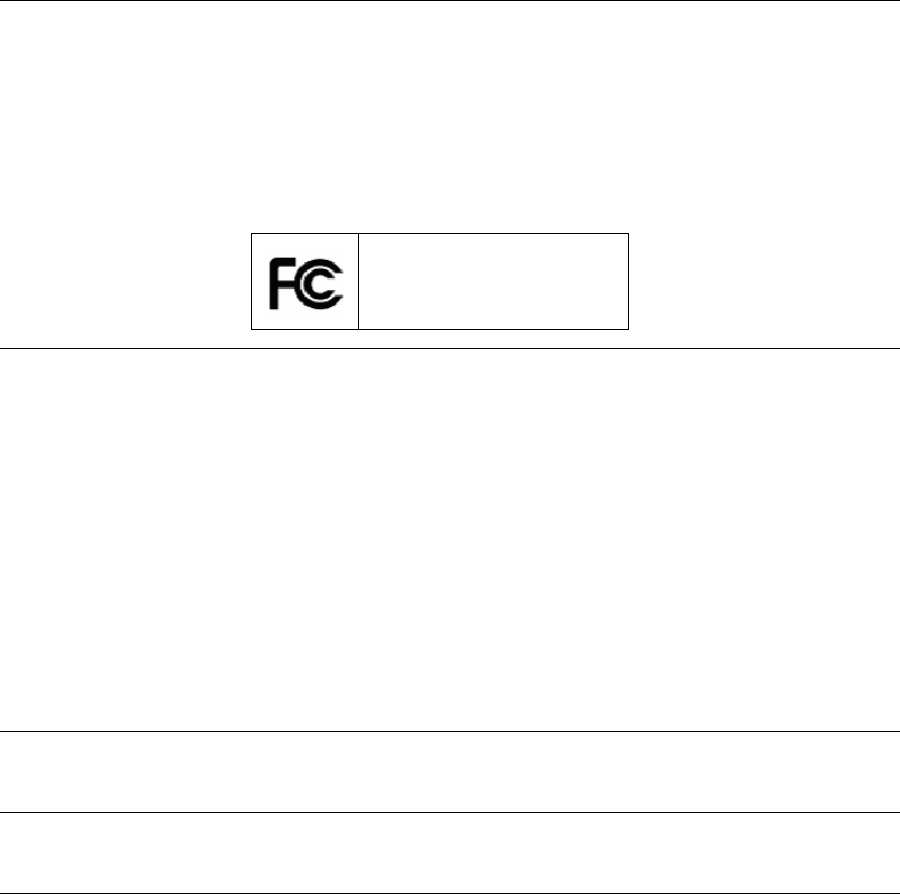
136
The correction of interference caused by such unauthorized modification, substitution or attachment will be
the responsibility of the user.
Changes or modifications not expressly approved by 3Com could void the user's authority to operate this
equipment.
US MANUFACTURER'S FCC
DECLARATION OF
CONFORMITY
3Com Corporation
350 Campus Drive
Marlborough, MA 01752-3064, USA
(508) 323-5000
Date: April 24, 2008
Declares that the Product:
Brand Name: 3Com Corporation
Model Number: WL-602
Equipment Type: 3Com Wireless 11n Cable/DSL Firewall Router
Complies with Part 15 of the FCC rules. Operation is subject to the following two conditions: (1) this device
may not cause harmful interference, and (2) this device must accept any interference received, including
interference that may cause undesired operation.
INDUSTRY CANADA - RF
COMPLIANCE
This device complies with RSS-210 of the Industry Canada Rules.
Operation is subject to the following two conditions:
1) this device may not cause interference and, 2) this device must accept any interference, including
interference that may cause undesired operation of the device.
L ' utilisation de ce dispositif est autorisee seulement aux conditions suivantes: (1) il ne doit pas produire de
brouillage et (2) l' utilisateur du dispositif doit etre pret a accepter tout brouillage radioelectrique recu, meme
si ce brouillage est susceptible de compromettre le fonctionnement du dispositif.
This Class B digital apparatus complies with Canadian ICES-003.
Cet appareil numerique de la class B est conforme a la norme NMB-003 du Canada.
IMPORTANT NOTE:
IC Radiation Exposure Statement:
This equipment complies with Canada radiation exposure limits set forth for uncontrolled environments. This
equipment should be installed and operated with minimum distance 20cm between the radiator & your
body.
This transmitter must not be co-located or operating in conjunction with any other antenna or transmitter.
2.4GHz operation of this product in Canada is firmware-limited to channels 1 through 11.
INDUSTRY CANADA -
EMISSIONS COMPLIANCE
STATEMENT
This Class B digital apparatus complies with Canadian ICES-003.
AVIS DE CONFORMITÉ À LA
RÉGLEMENTATION
D'INDUSTRIE CANADA
Cet appareil numérique de la classe B est conform à la norme NMB-003 du Canada.
SAFETY COMPLIANCE NOTICE This device has been tested and certified according to the following safety standards and is intended for use
only in Information Technology Equipment which has been tested to these or other equivalent standards:
■UL Standard 60950-1
■CAN/CSA C22.2 No. 60950-1
■IEC 60950-1
■EN 60950-1
3Com Wireless 11n Cable/DSL Firewall
Router
Model WL-602

137
EU COMPLIANCE
Intended use: DSL/Cable 802.11g/b/n Firewall Router
For connection to DSL/Cable networks
NOTE: To ensure product operation is in compliance with local regulations, select the country in which the
product is installed. Refer to 3CRWER300-73 User Guide.
For connection to DSL/Cable networks
This equipment may be operated in:
AT BE CY CZ DK EE FI FR
DE GR HU IE IT LV LT LU
MT NL PL PT SK SI ES SE
GB IS LI NO CH BG RO TR
Česky
[Czech]
3Com Coporation tímto prohlašuje, ze tento RLAN
device je ve shodě se základními pozadavky a dalšími
příslušnými ustanoveními směrnice 1999/5/ES.
Dansk
[Danish]
Undertegnede 3Com Corporation erklærer herved, at
følgende udstyr RLAN device overholder de
væsentlige krav og øvrige relevante krav i direktiv
1999/5/EF.
Deutsch
[German]
Hiermit erklärt 3Com Corporation, dass sich das Gerät
RLAN device in Übereinstimmung mit den
grundlegenden Anforderungen und den übrigen
einschlägigen Bestimmungen der Richtlinie
1999/5/EG befindet.
Eesti
[Estonian]
Käesolevaga kinnitab 3Com Corporation seadme
RLAN device vastavust direktiivi 1999/5/EÜ
põhinõuetele ja nimetatud direktiivist tulenevatele
teistele asjakohastele sätetele.
English Hereby, 3Com Corporation, declares that this RLAN
device is in compliance with the essential
requirements and other relevant provisions of
Directive 1999/5/EC.
Español
[Spanish]
Por medio de la presente 3Com Corporation declara
que el RLAN device cumple con los requisitos
esenciales y cualesquiera otras disposiciones
aplicables o exigibles de la Directiva 1999/5/CE.
Ελληνική
[Greek]
ΜΕ ΤΗΝ ΠΑΡΟΥΣΑ 3Com Corporation ΔΗΛΩΝΕΙ ΟΤΙ
RLAN device ΣΥΜΜΟΡΦΩΝΕΤΑΙ ΠΡΟΣ ΤΙΣ
ΟΥΣΙΩΔΕΙΣ ΑΠΑΙΤΗΣΕΙΣ ΚΑΙ ΤΙΣ ΛΟΙΠΕΣ ΣΧΕΤΙΚΕΣ
ΔΙΑΤΑΞΕΙΣ ΤΗΣ ΟΔΗΓΙΑΣ 1999/5/ΕΚ.
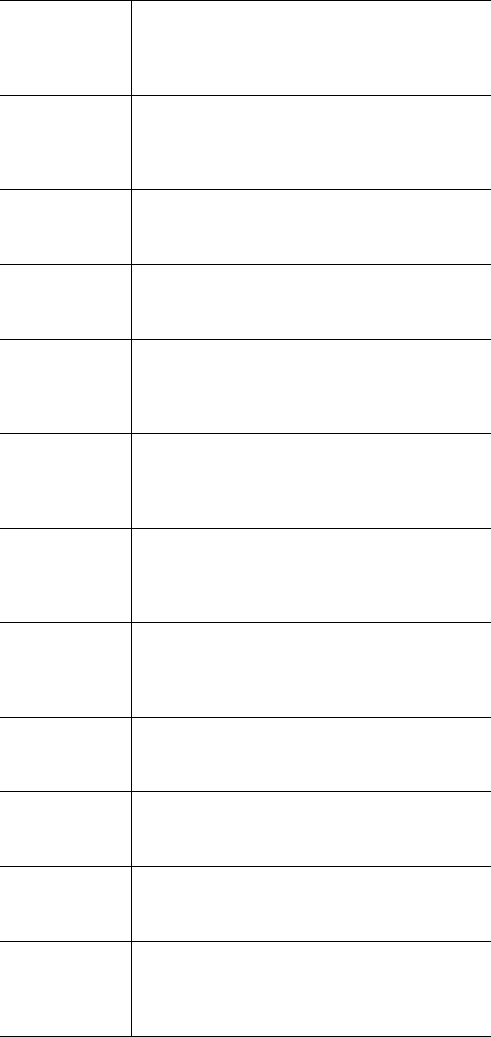
138
A copy of the signed Declaration of Conformity can be downloaded from the Product Support web page for
the 3Com Wireless 11n Cable/DSL Firewall Router at http://www.3Com.com.
Also available at http://support.3com.com/doc/WL-602_EU_DOC.pdf.
Français
[French]
Par la présente 3Com Corporation déclare que
l'appareil RLAN device est conforme aux exigences
essentielles et aux autres dispositions pertinentes de
la directive 1999/5/CE.
Italiano
[Italian]
Con la presente 3Com Corporation dichiara che
questo RLAN device è conforme ai requisiti essenziali
ed alle altre disposizioni pertinenti stabilite dalla
direttiva 1999/5/CE.
Latviski
[Latvian]
Ar šo 3Com Corporation deklarç, ka RLAN device atbilst
Direktîvas 1999/5/EK bûtiskajâm prasîbâm un citiem ar to
saistîtajiem noteikumiem.
Lietuviø
[Lithuanian]
Šiuo 3Com Corporation deklaruoja, kad šis RLAN
device atitinka esminius reikalavimus ir kitas
1999/5/EB Direktyvos nuostatas.
Nederlands
[Dutch]
Hierbij verklaart 3Com Corporation dat het toestel
RLAN device in overeenstemming is met de essentiële
eisen en de andere relevante bepalingen van richtlijn
1999/5/EG.
Malti
[Maltese]
Hawnhekk, 3Com Corporation, jiddikjara li dan RLAN
device jikkonforma mal-htigijiet essenzjali u ma
provvedimenti ohrajn relevanti li hemm fid-Dirrettiva
1999/5/EC.
Magyar
[Hungarian]
Alulírott, 3Com Corporation nyilatkozom, hogy a RLAN
device megfelel a vonatkozó alapvetõ
követelményeknek és az 1999/5/EC irányelv egyéb
elõírásainak.
Polski
[Polish]
Niniejszym 3Com Corporation oświadcza, że RLAN
device jest zgodny z zasadniczymi wymogami oraz
pozostałymi stosownymi postanowieniami Dyrektywy
1999/5/EC.
Português
[Portuguese]
3Com Corporation declara que este RLAN device está
conforme com os requisitos essenciais e outras
disposições da Directiva 1999/5/CE.
Slovensko
[Slovenian]
3Com Corporation izjavlja, da je ta RLAN device v
skladu z bistvenimi zahtevami in ostalimi relevantnimi
določili direktive 1999/5/ES.
Slovensky
[Slovak]
3Com Corporation týmto vyhlasuje, ze RLAN device
spĺňa základné poziadavky a všetky príslušné
ustanovenia Smernice 1999/5/ES.
Suomi
[Finnish]
3Com Corporation vakuuttaa täten että RLAN device
tyyppinen laite on direktiivin 1999/5/EY oleellisten
vaatimusten ja sitä koskevien direktiivin muiden
ehtojen mukainen.
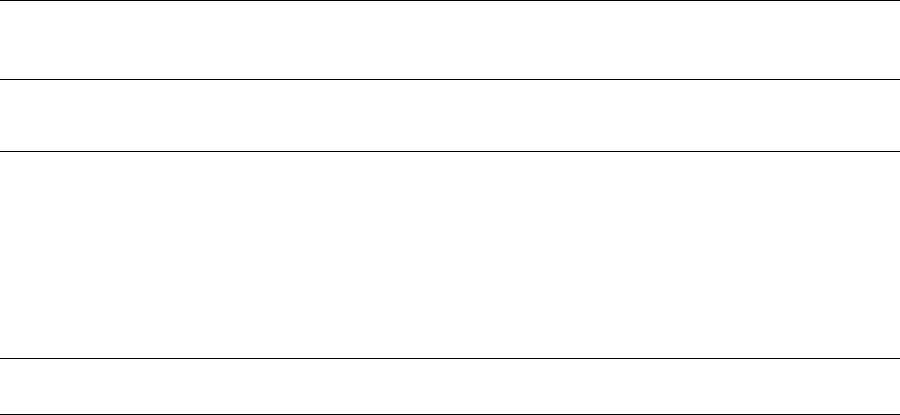
139
EU - RESTRICTIONS FOR USE
IN THE 2.4GHZ BAND
This device can be operated in the EU without restrictions indoor. However, operated outdoors in France is
restricted to 2400 ~ 2454 MHz : (Channel 1 ~ 7).
BRAZIL RF COMPLIANCE Este equipamento opera em caráter secundário, isto é, não tem direito a proteção contra interferência
prejudicial, mesmo de estações do mesmo tipo, e não causar interferência a sistema operando em caráter
primário.
DGT STATEMENT 1. 經審驗合格之射頻電信終端設備 ,非經許可, 公司 商號或使用者均不得擅自變更頻率, 加大功率或
變更原設計之特性及功能。
2. 射頻電信終端設備之使用不得影響飛航安全及干擾合法通信;經發現有干擾現象時,應立即停用,並
改善至無干擾時方得繼續使用。所謂合法通信,係指依電信法規定作業之無線電信。
3. 輸入、製造射頻電信終端設備之公司、商號或其使用者違反本辦法規定,擅自使用或變更無線電頻率、
電功率者,除依電信法規定處罰外,電信總局並得撤銷其審驗合格證明。
4. 本機限在不干擾合法電台與不受被干擾保障條件下於室內使用。
5. 為減少電磁波干擾, 請妥適使用。
SAFETY STATEMENT This product is intended to be supplied by a UL listed power unit marked “Class 2” or ‘LPS” rated 15V dc
minimum 1A or 12V dc minimum 1A.
PANASONIC LICENSED PATENT
NUMBER
Only for xDSL Product
Licensed under one or more of U.S. Patent Nos.6694470; 6735245; 6751254; 6765957; 6768772; 6873652;
6901547; 6917647; 6934326; 6950459; 6952442; 6987802; 6999506; 7012954; 7051258; 7058123; and
7272173
140

INDEX
Numbers
128-bit WEP 46
128-bit WEP Screen 46
1483 Bridge Mode 55
64-bit WEP Screen 47
A
Access Control Screen 62
Add PC Screen 63
Add Schedule Rule Screen 65
Addresses
IP 85
Admin Password Screen 75
Advanced Screen 68
Automatic Addressing 87
B
Backup/Restore Settings Screen 74
Bridge Mode for Single PC Screen 53
Bridged Mode Configuration Screen 33
C
Cable Specifications 91
Channels 111
Configuration Summary Screen 37
Connection Type Screen 29, 50
Conventions
notice icons, About This Guide 8
text, About This Guide 8
D
DDNS 70
DHCP 87
DHCP Clients List 42
DHCP server 25, 42
disabling 26
DMZ Screen 67
DNS 24
DNS Screen 55
DSL mode 29
Dynamic Domain Server (DDNS) Screen 70
Dynamic IP Address 34
Dynamic/Fixed IP for Bridge Mode Screen 35, 55
DYNDNS 70
E
Editing DHCP Clients List Screen 42
Encryption Screen 44
Encryption, disabling 45
F
Firewall Screen 59
Forgotten Password 80
H
Hostname
configuring 56
Hostname and MAC Address Screen 56
I
Internet
addresses 85
Internet Properties Screen 26
Internet Protocol (TCP/IP) Properties Screen 24
IP Address 41, 85
IPSEC 68
L
LAN Settings Screen 41
LED 14
LEDs 14
Local Area Properties Screen 24
Logs Screen 77
M
MAC Address 56
configuring 56

142 INDEX
MAC Address Filtering Screen 66
mode 30
N
NAT (Network Address Translation) 68
NAT-T (NAT Traversal) 68
Network
addresses 85
Networking
wireless 81
NIC
wireless 14
P
Password 27, 75
Poison Reverse 58
PPPoA 31
PPPoA Screen 31
PPPoA Settings Screen 52
PPPoE 26, 30, 31
PPPoE Screen 30
PPPoE Settings Screen 51
R
Remote Admin 68
Reset to Factory Default Screen 73
Reset to Factory Defaults 80
Restart Router Screen 73
RFC 1483 Bridged Mode 32, 53
RFC 1483 Routed Mode 34
RIP (Routing Information Protocol) 57
RIP Parameter Screen 58
Router Login Screen 28
Routing Mode Screen 34
Routing Table Screen 59
S
Schedule Rule Screen 65
Setup Wizard 27
SNMP Community Screen 71
SNMP Trap Screen 72
Special Applications Screen 60
Specifications
technical 89
SSID 31, 32, 33, 35, 36, 43
Static Addressing 87
Static Route Parameters Screen 57
Status Screen 28, 40
Subnet Mask 85
T
TCP/IP 23, 25, 85
Technical
specifications 89
standards 89
Time and Time Zone screen 76
TZO.com 70
U
Universal Plug and Play 68
Upgrade Screen 74
URL Blocking Screen 64
V
Virtual Servers Screen 61
VPI/VCI 30, 32, 33, 34, 36
W
WAN Ping Blocking 68
WDS 49
Web Browser Location Field 27
Web Proxy 26
WiFi Protected Access 45, 48
Wireless
networking 81
NIC 14
Wireless Configuration Screen 43
Wireless Settings Screen 31, 32, 33, 35, 36, 43
Wireless WDS Settings Screen 49
WPA (with RADIUS Server) Screen 48
WPA-PSK (no server) Screen 45